 A
SMALL PIECE OF PARADISE
A
SMALL PIECE OF PARADISE
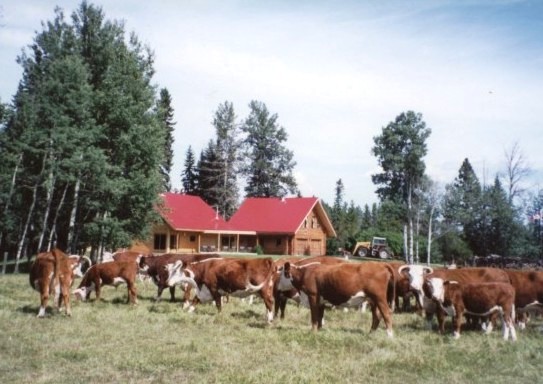 Memorial To My Off-Grid Home Memorial To My Off-Grid Home
This is the story of a Great
Adventure, the building of an off-grid home and ranch back in
the 1970s. It is still off-grid and running just fine, with
newer more efficient power of course.
It became known as "Rocking
Are Herefords", a ranch I built from scratch in the wilderness of
west central Alberta southwest of a town called Rocky Mountain
House. I lived there from 1977 through to
the fall of 2017, when my failing eyesight forced me to consider a
more secure setting in a condo on the west edge of Calgary. The
ranch was rented on a lease to purchase option in 2018 and
the sale was completed in 2021. The cows are gone - it is now a
horse operation, where unwanted horses find loving care until
new homes are found for them.
For a quick tour of the ranch, view this
Slide Show, then do what
the song says and Come Back to this page for more stories and
photos.
I first viewed the property,
a full quarter section (160 acres), in Feb 1976, walking in
about a mile on a well used snow-packed game trail. I found out
why it was so well used - it led to an open spring-fed stream,
a rare sight at latitude 52 in the dead of winter. I signed the
deal an hour later.
Come spring and summer, I was
not disappointed. Nearly every mammal and half the birds in the
Alberta wildlife books visited, including a bear who climbed 14
feet up a tree to capture a canned ham and some bug spray that
we had hung "out of reach" of predators. So I found an 8 by 32
foot trailer that had seen many better days in the Yukon in the
1950s and camped in it. Not really bear proof but better than
canvas.

My home for 40 years with Herefords in the front pasture.
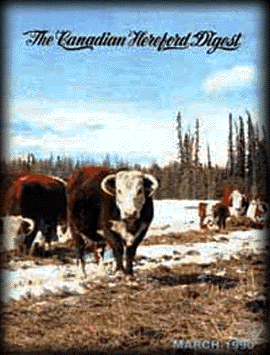
 Cover girls from the Rocking R Cover girls from the Rocking R
Over the next 3 years, I cleared the scrub,
built a milled-log house, and finally moved from Bragg Creek in 1978.
I laid up most of the logs myself, but had 2 carpenters do the
open-beam roof and finish carpentry. Being an electrical engineer, I wired
the house myself, setup a 4 KW wind generator, and charged re-claimed
telephone office batteries. The ranch was, and still is, 3 miles
from the nearest power line and nearest neighbour. The wind generator
died of fatigue and old age in 2001 and has
been replaced by a 8000 watt solar array.
In fall 1979, six bred
heifers and a herd bull (Horned Herefords) arrived. Using
self-study courses from Guelph University and an extension
course at Olds College, I quickly learned the basics of animal
husbandry, with considerable help from our local vets, Tom and
Martha Kostuck.
And the ranching operation grew from there. Now I was a rancher as well as
consulting Petrophysicist, two parallel careers that I loved
equally, although the hours were sometimes tough.
Between 1980 and
1984, I cleared, cultivated, and seeded another 240 acres of lease
land. I left all the good trees as windbreaks and shelter belts,
cultivating only willows and scrub brush. Some of the lease was sold
as it was not as productive as I had hoped.
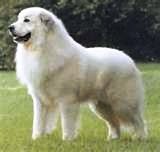 Cochiese,
the first of many Great Pyrenees that Cochiese,
the first of many Great Pyrenees that
kept the cattle and the homestead secure ==>
I had a
lot of help from contractors, tradesmen, part-time cowboys, and
good-hearted neighbours. People like Ed Carlson, Kent Maxwell,
Eric Hazen, and Walter Kupfer handled chores while I was busy at
other things. Hay suppliers, truckers, seed experts,
veterinarians, welders, mechanics, fuel suppliers, and loads of
others added their respective talents. Although I worked my ass
off, it was never a one-man job.
Cochiese, the first of several Pyrenees who
guarded the Ranch 


Bull power, not BS, was a motto we
followed at the Ranch
The
ranch needed a sequence of power more capable than the Mustang,
which was kept for commuting to Calgary until 1984. A Ford F250
4x4 and a 24 foot goose neck trailer were the order of the day,
and when the ranch was finished, these were replaced by a new
1982 Chevy S-10 4x4 that ran 'til 1997. It ran 200,000 miles and
rusted off its frame, just like the Mustang.






A flotilla of
tractors and farm machinery was acquired, and I drove these until
2001. I only wiped out two fences that I know of. I like red so the
tractors were all Massey Ferguson, but I'm not allowed to drive them
any more without a seeing-eye guide onboard.
From
1979 to 2005, we
raised purebred Hereford bulls and replacement females for commercial ranchers and
other purebred breeders. We
were told that our stock was "one of the best kept secrets
in the Hereford industry". Our bulls were Maternal Trait
Leaders and 10% of our cows showed up on the Top Producing Female
list most years.
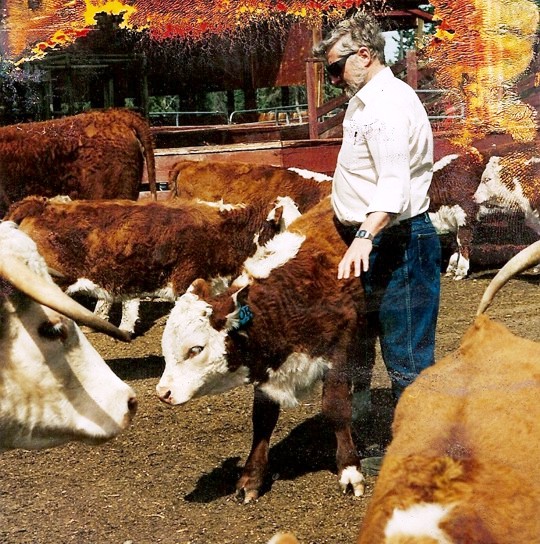
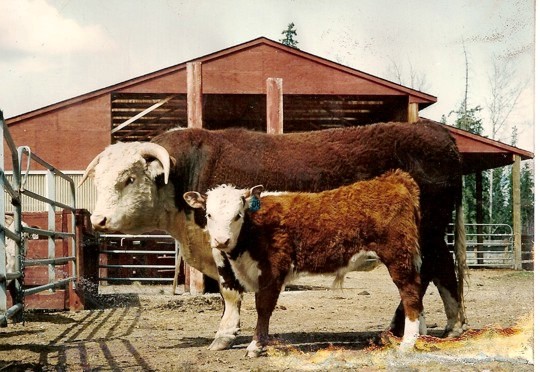
Yup,
that's me with Buddy on the left, Buddy with his real Dad at the
right.
In 2005, the heart of our herd was
sold to the Bohnet family of High River and the younger bred cows
were dispersed through Innisfail Auction. The bred heifers,
yearling bulls, and 2-year old bulls were sold in 2006. We ran grassers in the
summer until 2016 when the older than old eyes told me to quit.
The pastures were rented to a neighbour to keep the grass in good
condition.
We
put a lot of time and effort into our Herefords, not to mention
love and affection for the cows, their calves, and our great
bull power. We miss their peaceful
nature and truly mourn the loss of our “family”.
Forty years after the initial purchase, my eyesight had
deteriorated enough to tell me I had to move to a place that
required less effort. I retired from ranching and from the
consulting business in June 2016 and moved to a condo in
Calgary. It's nice but I really miss the peace and quiet of the Ranch!!
These webpages about my ranching days are meant as a memory
jogger for me as I creep slowly toward the final quarter century of my life.
Join me in reviewing this beautiful Piece of Paradise.
 THE RANCH
HOUSE THE RANCH
HOUSE
The modern, energy-efficient open-beam home,
built in 2002, is finished in pine log siding over structural
insulated panel walls and roof. An attached two car garage, constructed from
milled logs in 1980, has an immaculate one-bedroom guest suite above
(730 sq ft), with full bath, kitchenette, and large living room. Both
overlook pristine woods and pasture land in front and the stream
behind. In addition, a 330 sq ft screened porch "summer kitchen"
with BBQ augments the recreational space.

Ranch house with our
cow herd in the front pasture
Solar panels and a natural-gas-powered generator with inverter and
batteries provide reliable "off-the-grid" independence. Ample clear
water comes easily from a 90 foot drilled well.
Landscaped grass lawns and a rock garden, complete with garden
railway, complement the finish of the ranch house. Massive spruce,
pine, and aspen
trees shelter the home from the weather on three sides, giving an
unobstructed view to the south.
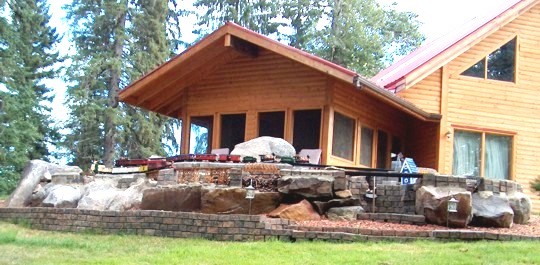
View of rock garden, garden railway, and large screened
porch on west side of ranch house.
There is a creek-side patio,
landscaped yard, and beautiful native trees. Some very large
glacial erratics were formed into a rock garden with a detailed
garden railway. Wildlife of all kinds visited
daily. The Great Pyrenees dogs kept the house and cattle safe
from predators and were great hiking and fence repair companions.
 THE
LAND THE
LAND
There are 160 acres deeded land,
surrounded by Crown Land on
all sides, with 120
acres of tame pasture, all accessible by high grade interior roads. Extensive
cross-fencing, with high-grade galvanized steel gates, affords excellent
control for rotational grazing. Carrying capacity is 50
cow-calf pairs summer grazing (winter feed purchased).
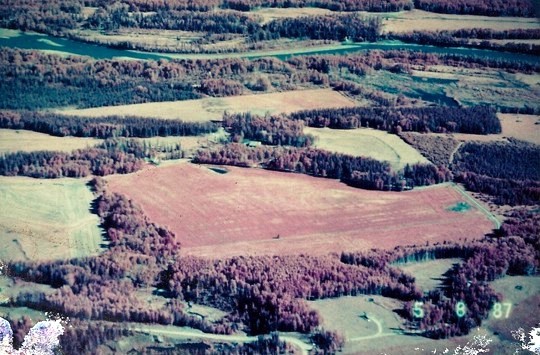
Aerial view of deeded
quarter and a portion of adjacent grazing lease (foreground) looking a little
east of north, North Saskatchewan River in background, Cowtown at center of photo.
Surrounded on all sides by government land, this property is an
oasis in the wilderness. A year-round stream, 80 foot pine, spruce
and aspen shelterbelts, and ample tame pastures make this a
practical working cattle or horse ranch, personal retreat, rural
residence, private hunting lodge, or all of these.
The ranch sits just 1/2 mile from the North Saskatchewan River and
two miles from the largest Forest Reserve in North America. Hunting,
fishing, hiking, and recreational travel are only yards from the
front door. World-famous Banff and Jasper National Parks are 110
miles from Rocky Mountain House, offering skiing, hiking, and the
spectacular Canadian Rockies scenery. Calgary and Edmonton, both 1
million plus population centers, offer everything in shopping and
entertainment that might be desired, and Red Deer is only an hour
away with most big city amenities.

Aerial photo of NE 24-39-9W5 showing internal roads, creek,
drainage, buildings, and pastures.
 THE
CATTLE FACILITIES THE
CATTLE FACILITIES
Cattle handling facilities are modern and in good repair, consisting
of a large hay barn with attached calving pens, heated maternity
barn with bunkhouse, kitchen and office, plus numerous smaller
outbuildings and corrals. A covered shelter over the working chute,
weigh scales, and squeeze keeps the cowboys dry while processing
cows or calves. This area, known as Cowtown, is the envy of the
community and praised by all the vets who have used it to treat a
sick animal.
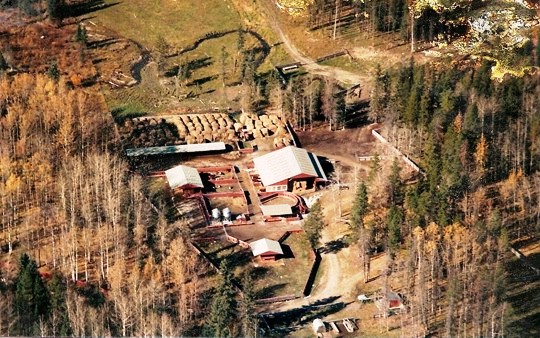
Cowtown
buildings looking West.
Keep scrolling down to see more photos of the land, buildings,
machinery, bulls, cows, calves, dogs, and cats that make up a
working ranch.
 ACCESS
ROAD ACCESS
ROAD
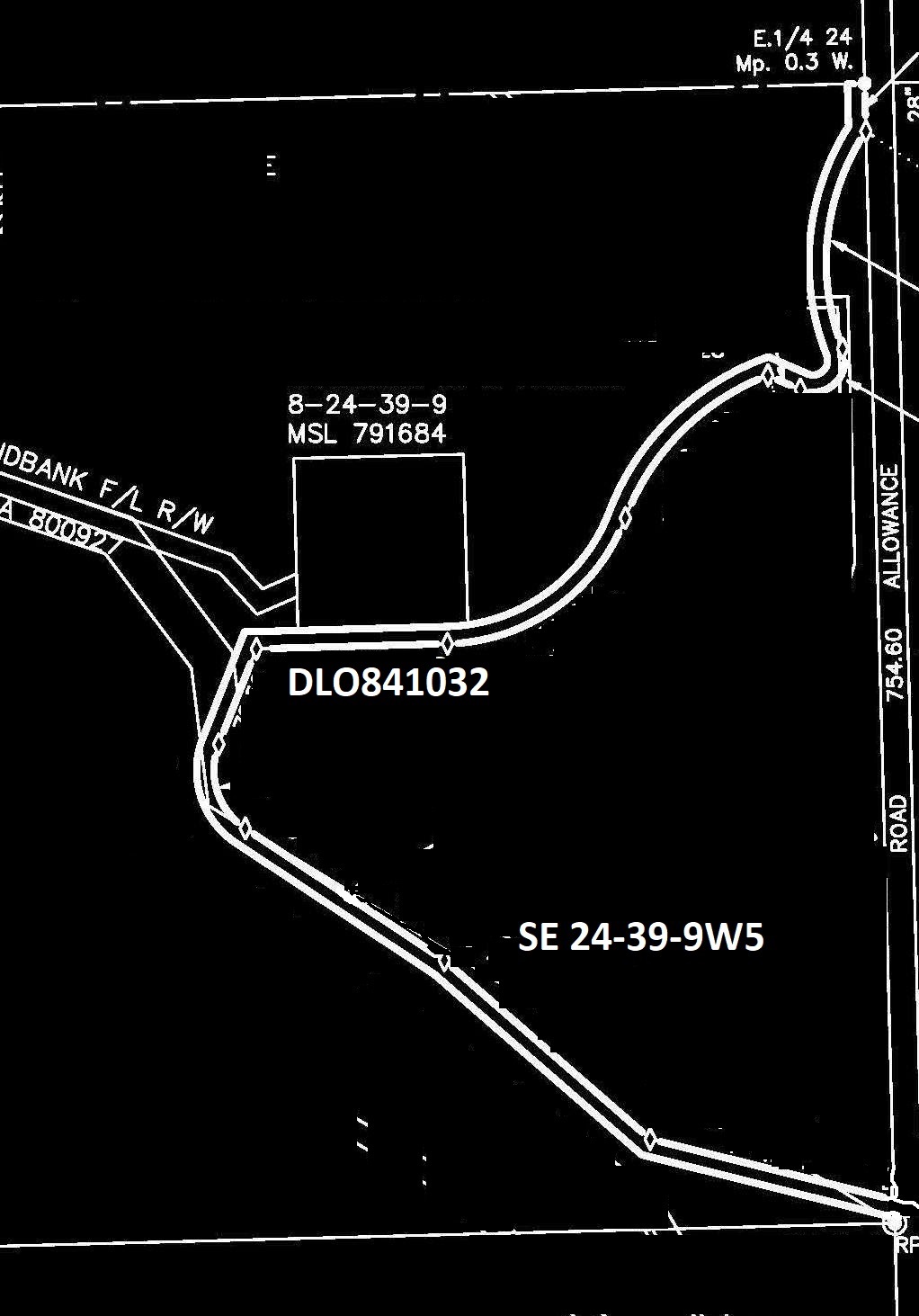 The
access road to the property is covered by a License of Occupation
issued by the Provincial Government. It connects the end of Range
Road 9-0 through Crown Land to the southeast corner of the deeded
property. The License has been in existence since sometime in the
1960's. The road is maintained by the land owner. The
access road to the property is covered by a License of Occupation
issued by the Provincial Government. It connects the end of Range
Road 9-0 through Crown Land to the southeast corner of the deeded
property. The License has been in existence since sometime in the
1960's. The road is maintained by the land owner.
Map of Access Road showing the route from the Municipal road
(bottom right) to the deeded land (top right). Commercial
operators who use the road continue westbound (top left of map)
and do not come anywhere near the deeded property. ==>
A portion of the
road is used by commercial operators under Road Use Agreements with
the License Holder. The License is conveyed with the deeded property
when the property is sold or transferred so that access cannot be
denied.
It is a high grade gravel road with ditches and culverts, and
cattle guards with gates, except on the portion used by commercial
operators.
The land traversed by the road is a Crown Grazing Lease so cattle
may be present from April through September each year.
 LOCATION
MAP LOCATION
MAP
GPS
52.37409 N 115.15982 W
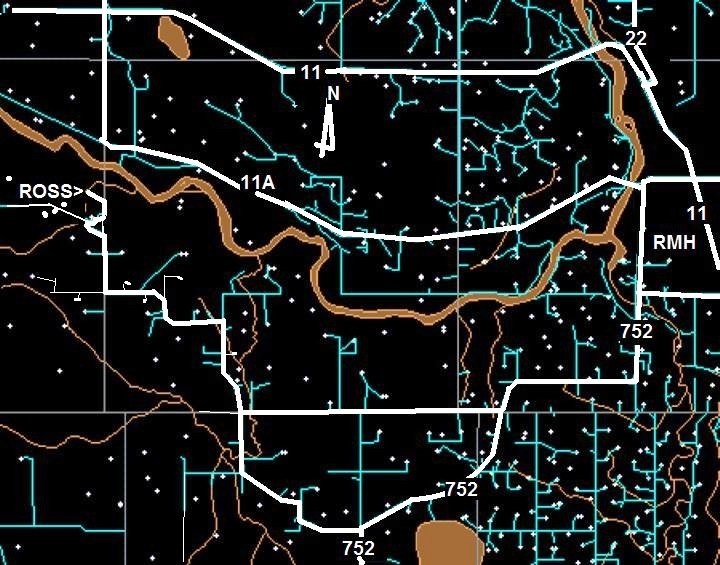
Road Map from
Rocky Mountain House (RMH) to Rocking "Are" Ranch (Ross).
GPS coordinates: 52.37409N 115.15982W ALS
Survey: NE24-39-9W5
 A PROPERTY FOR ALL SEASONS
A PROPERTY FOR ALL SEASONS
Photo Essay
All photos on this page taken by E. R. Crain.

Completely off the grid with solar power and natural gas heat.
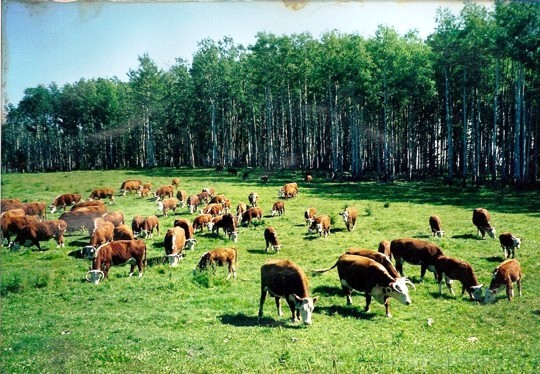
Meadow foxtail makes good grass, and in turn makes for healthy critters.
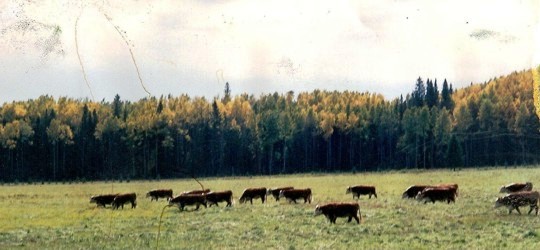
View of south pasture from the front window of the ranch house - pastoral and peaceful.

Raking hay in south pasture, as seen from living room.
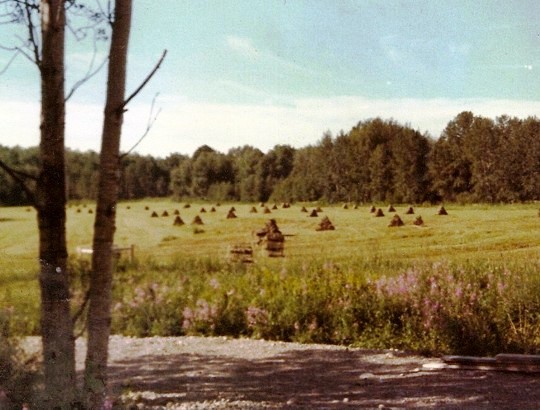
All baled and ready to go. We upgraded to a stackmaker the following
year.
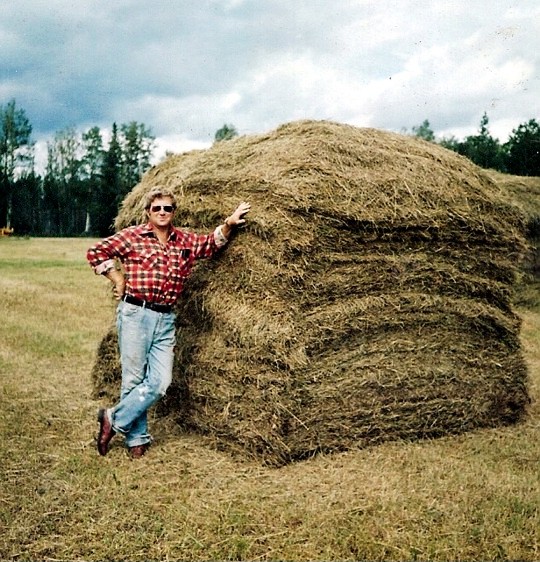
How's that for nonchalance - breadloaf stacks were made with a
Hesston stackmaker.
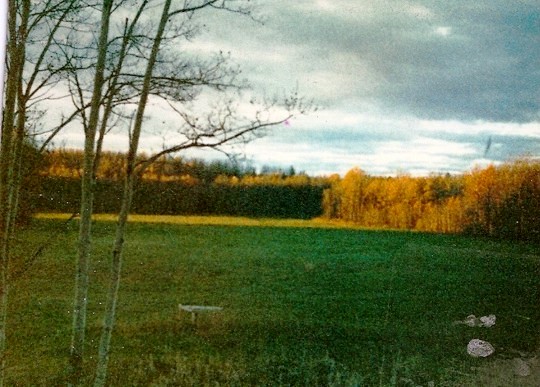
Fall colour spectacular - harvest is in the barn.
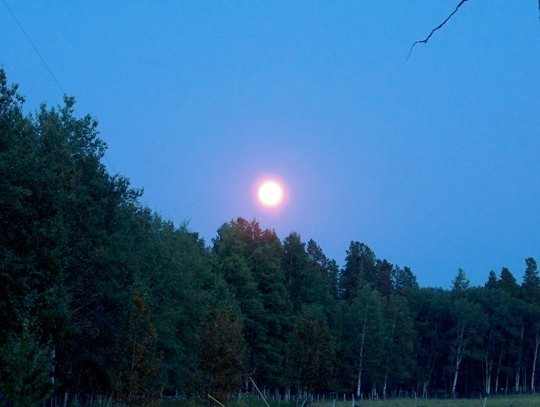
Moonrise after fall harvest
Click here
to see photo showing craters and stars from handheld shot (1.6 Mb)

Frost on the trees at sunrise - calving season coming next.
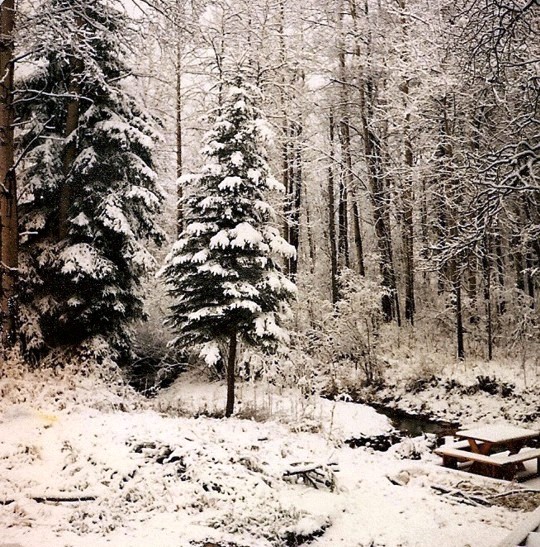
The spring-fed creek runs all winter - a rare sight in Alberta.
This view
was taken from the side lawn.
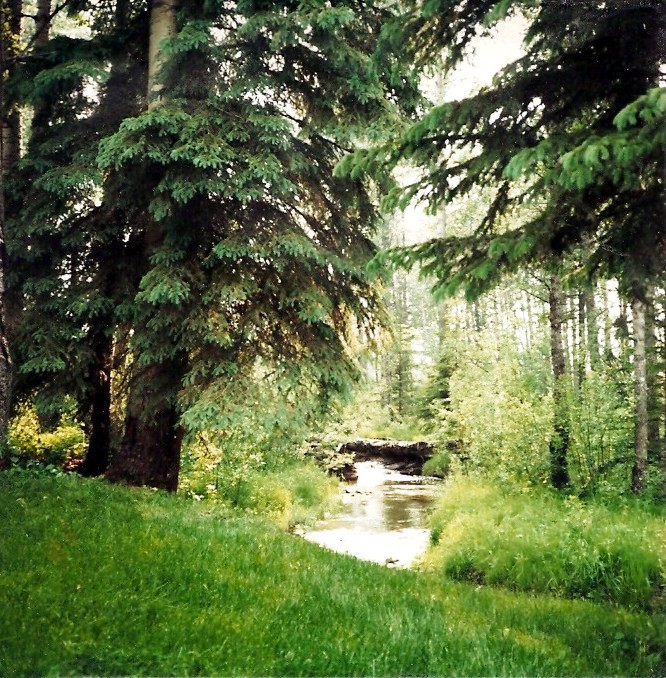
Spring has sprung - here's the creek again, viewed from the side lawn.
 MEMORIES
OF THE CATTLE
MEMORIES
OF THE CATTLE
Photo Essay
From
1979 to 2005, we
raised purebred Hereford bulls and replacement females for commercial ranchers and
other purebred breeders.
We
were told that our stock was "one of the best kept secrets
in the Hereford industry". Our bulls were Maternal Trait
Leaders and 10% of our cows showed up on the Top Producing Female
list most years.
In 2005, the heart of our herd was
sold to the Bohnet family of High River and the younger bred cows
were dispersed through Innisfail Auction. The bred heifers,
yearling bulls, and 2-year old bulls were sold in 2006. Until
2016, we ran grassers in the
summer and leased some grass to keep the pastures in good
condition. Failing eyesight forced me off the ranch in
2017.
We
put a lot of time and effort into our Herefords, not to mention
love and affection for the cows, their calves, and our great
bull power. We miss their peaceful
nature and truly mourn the loss of our “family”.


FA
Silver Canadian ET 37D LCI
Royal Red ET 83A
Total Maternal EPD +42 Total Maternal EPD +42

Read more about the herd and our bulls at
Rocking
"Are" Herd History.
 OUR
CATTLE AT WORK
OUR
CATTLE AT WORK
Photo Gallery
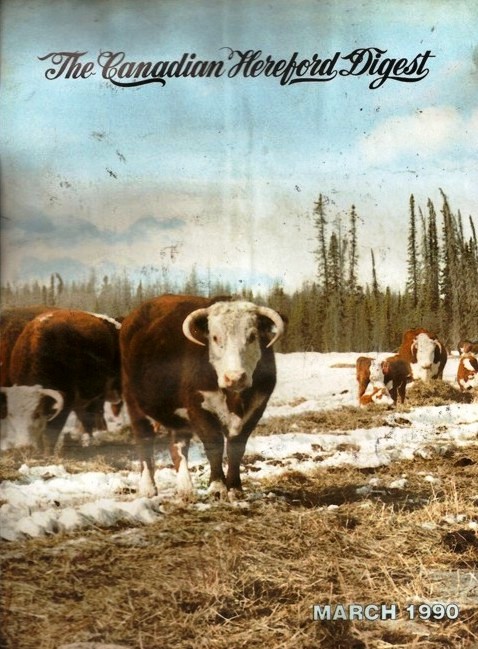
In March 1990 we made the cover of Canadian Hereford
Digest . Thanks to Kurt Gilmore, Editor, CHD and to Marty Ross who
took the photo.
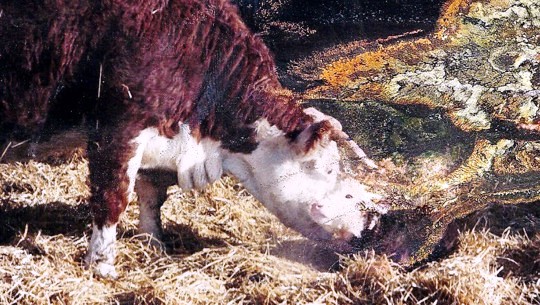
A mother's love, minutes after birth - new life and new hope.
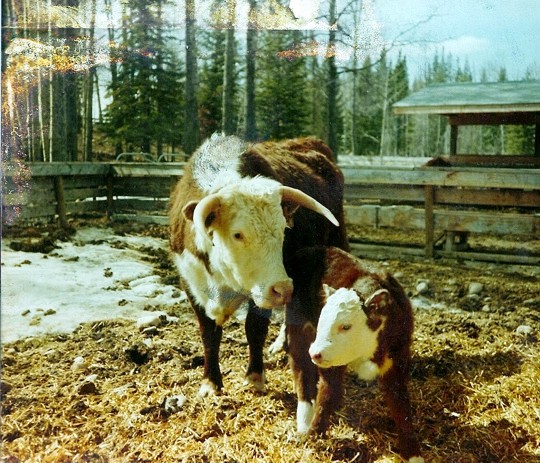
Newborn, warm, dry, and well-fed.

Cow and calf at work.
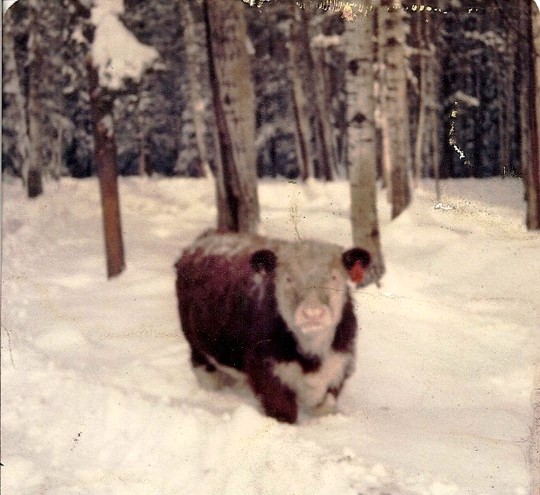
If only calves could talk - @#$%%$# @##$@!
SNOW!

Buddy and his Dad, both as tame as puppy dogs.

Buddy and his real Dad.
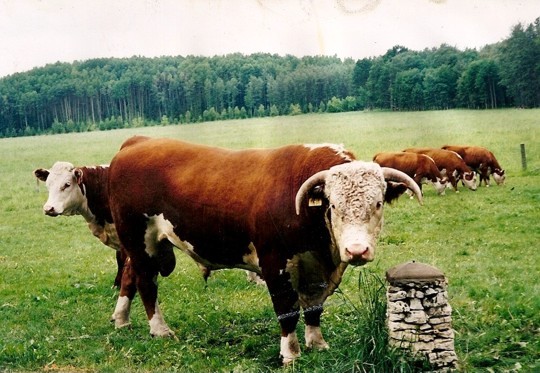
The fence climber in the front yard, with a girl friend.
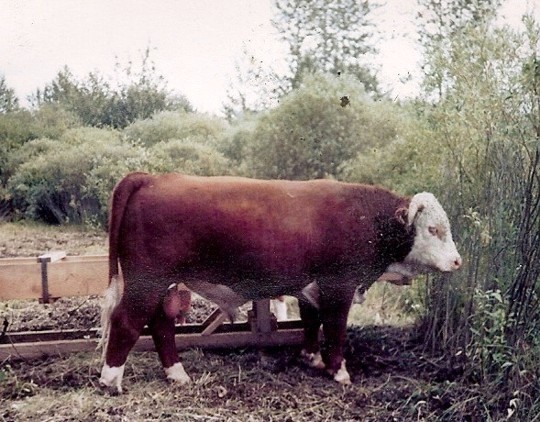
Taimi Mark Broen 17L - our first bull, purchased from Walter
Berger, Taimi, in 1980.

HH Advance N194 -one of the best cow producers in the industry,
purchased in
1986 at Peacock dispersal.
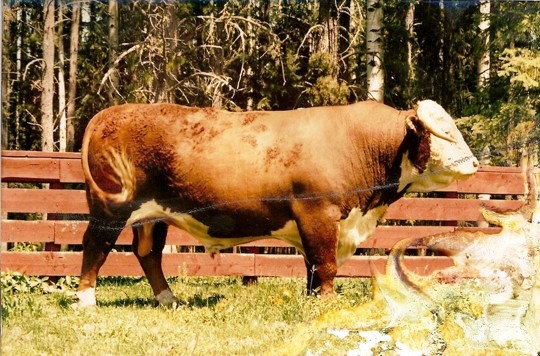
GH Britisher 3X was obtained from the Hansen dispersal in 1993,
replacing N194
who died in service of heart failure.
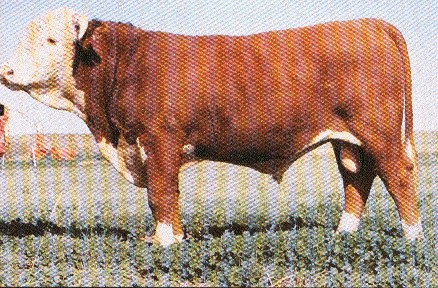
LCI Royal Red 83A, one of the best maternal trait bulls in the
industry,
purchased from the Floyd Anderson dispersal in 1995.
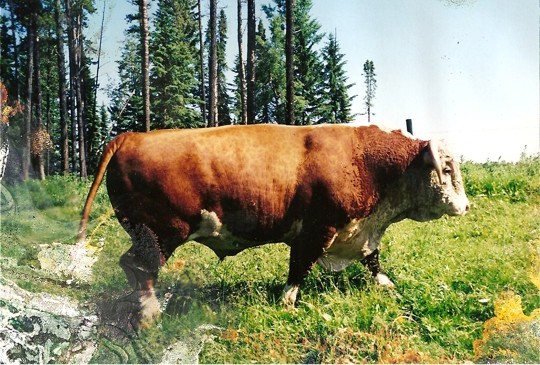
FA Silver Canadian 37D, another maternal trait leader, came from
Bjorger Pettersen in
1998, and served us well.
 HERD
HISTORY HERD
HISTORY
Bull Power With Maternal Traits
1979
- 1981
 In
the fall of 1979, I purchased six bred heifers and a long yearling
bull from Walter Berger of Taimi, just east of Rocky Mountain
House. Taimi Mark Brown Lad 17L served us for the first four seasons.
Four of the original six cows gave us 17 calves each, and appeared
in the CHA superior cow list for several years. Daughters and
grand daughters are still in the herd. Several sons sold at the
AHA Test Center for good prices. In
the fall of 1979, I purchased six bred heifers and a long yearling
bull from Walter Berger of Taimi, just east of Rocky Mountain
House. Taimi Mark Brown Lad 17L served us for the first four seasons.
Four of the original six cows gave us 17 calves each, and appeared
in the CHA superior cow list for several years. Daughters and
grand daughters are still in the herd. Several sons sold at the
AHA Test Center for good prices.
I
was a rank amateur in ranching, and learned a lot by trial and
error, plus the tremendously valuable courses and literature from
Alberta Ag, Olds College, and University of Guelph. The recurring
theme I learned was “Nutrition is everything”. That
means a balanced ration – not over-feeding!
A
good vaccination program, a complete mineral formula, clean bedding,
and parasite control will take care of the rest of animal health
concerns. Society would do well to look after the human race as
well as we look after cattle.
1982
 I
was proud of our weights and advertised them in 1982 and 1983,
well before the current emphasis on EPDs in modern advertising. I
was proud of our weights and advertised them in 1982 and 1983,
well before the current emphasis on EPDs in modern advertising.
I
also believed that the THE (Total Herd Evaluation) program sponsored
by the Canadian Hereford Association would lead to considerable
herd improvement – which it did. Every animal in our herd
has been enrolled, with actual measured birth and weaning weights
submitted. We did not high-grade our EPDs by leaving out the culls.
Most
of our customers today still have no idea what EPDs do for them,
but I believe it helps produce sound, middle-of-the-road animals
for local customers. Since I stress maternal traits, EPDs are
essential in choosing herd sires and “keeper” cows.
My
deteriorating eyesight forced me to stop driving, so it was hard
to get to sales, shows, and social events. It also meant that
I could not recognize faces easily. It makes “face-to-face”
marketing, so necessary in the purebred business, really difficult!
1983
 Our
1983 herd sire advert still featured “Brownle” and
our statistics. We added cows from Stauffer Farms and the Bar
77 (Zane Block) dispersal. The Bar 77 cows were very modern for
their time, and lasted a long time at Rocking “Are”.
Daughters and grand daughters are still doing well here. Our
1983 herd sire advert still featured “Brownle” and
our statistics. We added cows from Stauffer Farms and the Bar
77 (Zane Block) dispersal. The Bar 77 cows were very modern for
their time, and lasted a long time at Rocking “Are”.
Daughters and grand daughters are still doing well here.
Ranch
construction was pretty well finished in 1983. These facilities
have also served well over the years. They were designed by me
for one-man operation as much as possible. It’s always more
efficient with a two-person crew, but three are seldom needed.
We
calve in January and February and, until 1991, did not have a
heated barn. This made for a few cold nights, frozen ears, and
slow starters.
A
lot of time was spent improving pasture, clearing lease land under
the Range Improvement Program, and cross-fencing in anticipation
of intensive grazing.
1984
 In
1984, we acquired the first of several proven bulls that significantly
improved our herd. PVC Britisher 29M came from the Pleasant Valley
Colony herd dispersal. He bred only one season prior to being
hit by lightning. “Brownie” bred his last group of
cows in 1984 and was retired from service. In
1984, we acquired the first of several proven bulls that significantly
improved our herd. PVC Britisher 29M came from the Pleasant Valley
Colony herd dispersal. He bred only one season prior to being
hit by lightning. “Brownie” bred his last group of
cows in 1984 and was retired from service.
We
added a heifer group from Stauffer and Ulrich, but these were
low-end, low-priced critters and did not live up to our expectations.
Out of twenty head, only one stayed in the herd for more than
three years, based entirely on their calves growth rates.
We
worked at a conception-to-consumer marketing plan, selling to
a local restaurant, a hotel near Drumheller, and to a private
trade, using a local butcher for the cut and wrap. With a small
herd, it was difficult to have a fat animal ready at all times,
but we kept it up for several years.
I
made more profit on the beef sales than live cattle by quite a
margin. It was a good education in the beef industry and helped
me understand the feedlot, packer, and retail side of the business.
1985
 I
arranged a bull sharing deal with Tom Irwin in 1985. I bred the
early season. He picked up the bulls on June 1 and he bred the
later season. One bull was wintered at each ranch. LCI Dermot
Lad 130P was a great bull but he was put down because of lumpjaw.
With 29M killed by lightning, we were out of bulls! I
arranged a bull sharing deal with Tom Irwin in 1985. I bred the
early season. He picked up the bulls on June 1 and he bred the
later season. One bull was wintered at each ranch. LCI Dermot
Lad 130P was a great bull but he was put down because of lumpjaw.
With 29M killed by lightning, we were out of bulls!
We
used 93J by AI as part of our program and did cleanup with 130P.
Because of the distance between us and the AI tech, we were not
very successful and never tried AI again.
I
became active in the Central Alberta Hereford Club as a Member
and later as a Director. I initiated the CAHC Newsletter, and
by personally inviting all Hereford breeders to re-join the Club,
I raised the membership from less than 20 to more than 60 in four
years. The Club is still very strong and has sponsored excellent
field days and ranch tours throughout Central Alberta.
1986
 With
the death of 29M and 130P, I needed a new bull for 1986. HH Advance
N194 was obtained from the Peacock dispersal. He was a great cow
builder, leaving perfect udders and feet. He ranked in the top
thirty Canadian Herefords for weaning and yearling weights. With
the death of 29M and 130P, I needed a new bull for 1986. HH Advance
N194 was obtained from the Peacock dispersal. He was a great cow
builder, leaving perfect udders and feet. He ranked in the top
thirty Canadian Herefords for weaning and yearling weights.
A
dozen of his daughters are still in the herd (2001) and many were
sold to local ranchers and other breeders. N194 daughters are
still coveted by knowledgeable breeders.
I
helped arrange the 1987 CAHC Tour through the West Country. We
received many compliments on our facilities and cattle.
Heifers were added to the herd from a “brand name”
dispersal. Three out of four did not breed after five months with
the bull. We had 100% conception on our home-raised heifers. Name
brand cattle are no better than those from small breeders, especially
if the breeder’s emphasis is on the Calgary Bull Sale instead
of herd fertility.
1987
- 1989
 In
1987, we put more effort into advertising. The double rainbow
photo taken in my front yard by my father was a dramatic symbol
of the pot of gold that Herefords could provide. No one ever commented
on the ad, but we used it as a background for several years. In
1987, we put more effort into advertising. The double rainbow
photo taken in my front yard by my father was a dramatic symbol
of the pot of gold that Herefords could provide. No one ever commented
on the ad, but we used it as a background for several years.
N194
continued as our senior bull. We acquired Tom Irwin’s heifer
crop prior to his dispersal. After several years of long calving
seasons, I gave up and culled all late comers - a heart-breaking
but necessary step.
Our
major sale outlet for breeding stock was the West Country Hereford
Sale held in Caroline. We and four other West Country breeders
set up this sale to showcase both polled and horned Herefords.
We participated until 1993, when the sale disbanded due to retirement
of two of the main contributors. Managing and planning joint sales
are a mix of diplomacy and compromise, traits not common to independent
ranchers.
1990
 In
1990, we arranged a bull-sharing agreement with Art Link. He was
smitten by N194 and I really liked his 20P bull. We shared the
rainbow ad for several years. 96P was never used at Rocking “Are”
but he was a great performer at Link’s. In
1990, we arranged a bull-sharing agreement with Art Link. He was
smitten by N194 and I really liked his 20P bull. We shared the
rainbow ad for several years. 96P was never used at Rocking “Are”
but he was a great performer at Link’s.
Our
joint efforts put a lot of good females into commercial herds.
A
photo of our herd taken by Marty Ross in the spring of 1989 appeared
on the cover of the March 1990 Hereford Digest. We received more
phone calls on this event than from all other ads combined.
The
heifer I received from Art Link as a signing bonus for the bull
sharing deal turned out to be one of the top five cows in our
herd.
Many
of our sales are direct off the ranch. Select animals have sold
at the AHA Test Center and the CAHC Supremacy Sale. Some cows,
heifers, and cow/calf pairs sell at Cole’s Auction in Rocky
Mountain House.
1991
– 1994
 We
used much the same joint We
used much the same joint
ad again in 1991 and 1992, but with more
detail about the herd sires. The bull battery did not change.
HH
Advance N194 died in service in 1992 from heart failure. GH Britisher
3X was obtained in 1993 from the Hansen Dispersal as a replacement.
We called him “Lightning” because of his mellow temperament
and quick attention to his ladies. Lightning stayed with us until
he died of old age in 1998.
We
also picked a Coulee Crest bull, 41Z, as our junior bull.
Our
cow herd was very stable during this period, with many N194 daughters
performing extremely well.
The
West Country Hereford Breeders sponsored the CAHC Tour for 1993.
While I was on vacation, two of the West Country breeder’s
decided that no Field Day events would be held – much to
the distress of the CAHC. The rationale for this decision was
never explained satisfactorily. CAHC did arrange a separate Field
Day at Coulee Crest and Rocking “Are” sponsored the
music, to help make amends for the stupidity of the WCHB decision.
I may sound a bit bitter here but I was terribly distressed by
the WCHB decision and lost a lot of credibility at CAHC meetings.
1995
 We
acquired LCI Royal Red 83A from the Floyd Anderson dispersal.
We still had 41Z, 3X, and a good junior bull, so we were pretty
“bull-rich”. Our bull sharing with Art Link came to
a sad end with his untimely passing. We
acquired LCI Royal Red 83A from the Floyd Anderson dispersal.
We still had 41Z, 3X, and a good junior bull, so we were pretty
“bull-rich”. Our bull sharing with Art Link came to
a sad end with his untimely passing.
41Z
and all junior bulls were retired in favour of the superior EPDs
of Royal Red and Lightning. We were also ruthless in culling low
efficiency critters, as always.
Our
intensive grazing program also paid off, as our weaning weights
continued to improve. Grass is our most important asset, and grass
management is crucial to economic success.
Rocking
“Are” had the high gaining horned bull at the AHA
Test Center. He was starved by his new owners and failed to breed.
The vet report showed his October weight to be less than his April
weight – what a waste!
1996
 By
1996, two of the best maternal bulls in the industry, 3X and 83A,
were working at Rocking “Are”. With a good base of
N194 cows, and a number of other good “name-brand”
cows, our calves looked great. Private treaty sales made it difficult
to keep the herd at its normal size, although prices were not
as high as expected. By
1996, two of the best maternal bulls in the industry, 3X and 83A,
were working at Rocking “Are”. With a good base of
N194 cows, and a number of other good “name-brand”
cows, our calves looked great. Private treaty sales made it difficult
to keep the herd at its normal size, although prices were not
as high as expected.
With
the help of my herdsman, Kent Maxwell, we made it to a few sales
and picked up a few of Edith Santee’s cows at her dispersal.
To
mark the beginning of a new era at Rocking “Are”,
I picked a new logo for the ads and Kurt Gilmore gave us a new
“modern look”. Did anyone notice?
Our
bull leasing program, begun in 1989, continued to be very popular.
It also gives us some well proven bulls to carry forward as two
year olds.
1997
 In
1997, we took the top performing bull, DW Advance 9012Y Lad 6F,
from the AHA Test Center for our heifers. The bull was a great
disappointment as he left many open heifers. Semen tests showed
the reason so he was pounded. The open heifers sold high but this
is faint compensation for too much hot feed and no exercise at
test. Another lesson learned! His only son, semen-tested A-OK,
serviced our heifers for two years until he broke his leg in 2001 In
1997, we took the top performing bull, DW Advance 9012Y Lad 6F,
from the AHA Test Center for our heifers. The bull was a great
disappointment as he left many open heifers. Semen tests showed
the reason so he was pounded. The open heifers sold high but this
is faint compensation for too much hot feed and no exercise at
test. Another lesson learned! His only son, semen-tested A-OK,
serviced our heifers for two years until he broke his leg in 2001
This
year we set up a toll free phone number and an email address to
make it easier to reach us. As far as I can determine, only one
rancher has ever availed themselves of these free services.
1998
 1998
saw 3X pass away from old age a month before breeding season.
A few frantic phone calls and we found FA Silver Canadian ET 37D
available from Bjorger Pettersen’s Ranch of the Vikings. 1998
saw 3X pass away from old age a month before breeding season.
A few frantic phone calls and we found FA Silver Canadian ET 37D
available from Bjorger Pettersen’s Ranch of the Vikings.
Combined
with Royal Red, we again had two of the industry’s top maternal
trait leaders. With the 3X and N194 maternal strength in the cow
herd we are sitting on the “best kept secret” in Alberta
Herefords – superior maternal values with reasonable birth
weights, unequaled udders, and perfect feet.
After
20 years of culling more than 280 cows and 500 heifers, it’s
nice to see the consistent results we have been looking for. It
sure takes a while!

1999
- 2000
We held our 20th Anniversary Sale in April 1999. Called “The
Millennium Event”, it was a great success. Calves from our
stock went on to obtain great prices at the AHA Hereford Supremacy
Sale in Innisfail. Congratulations to these observant breeders.
Millennium Event II, scheduled for April 2000, was cancelled when
private treaty sales cleaned out our sale prospects.

2001
- 2003
 Three
years of drought have not hurt our grass due to careful monitoring
of our rotational grazing program, aided by some extra rain related
to our close proximity to the foothills and the North Saskatchewan
River. The swamps are dry, showing how far the water table has
dropped. Further North, East, and South, commercial herds are
suffering reductions. Three
years of drought have not hurt our grass due to careful monitoring
of our rotational grazing program, aided by some extra rain related
to our close proximity to the foothills and the North Saskatchewan
River. The swamps are dry, showing how far the water table has
dropped. Further North, East, and South, commercial herds are
suffering reductions.
We
lost Royal Red 83A to old age during the summer of 2001 and have
replaced him with one of his best sons, AOWI Red Millennium 3J.
FA Silver Canadian 37D continued in service until 2003, when his
age became a problem.
We
also picked up the high selling bull at LRD's 2001 fall sale,
AGF Sterling 78L, to service our heifer crop. Unfortunately, he
wasn't much interested in girls, so after 2 years of trying, we
gave him away for hamburger.
Our
part time herdsman, Kent Maxwell, was killed in a logging accident
in early 2002. Although his involvement in our herd had decreased
over the last few years, we lost a good friend and keen Hereford
eye.
2004 – 2006

 In 2005,
I received my Canadian Hereford Association 25-Year pin at the
annual summer field day. Later that year, the heart of our herd was
sold to the Bohnet family of High River and the younger bred cows
were dispersed through Innisfail Auction. The bred heifers,
yearling bulls, and 2-year old bulls were sold in 2006. In 2005,
I received my Canadian Hereford Association 25-Year pin at the
annual summer field day. Later that year, the heart of our herd was
sold to the Bohnet family of High River and the younger bred cows
were dispersed through Innisfail Auction. The bred heifers,
yearling bulls, and 2-year old bulls were sold in 2006.
You can blame my poor eyesight, the tail end of the BSE crisis,
and tired bones and body. I quit calving in the cold and the
dark of mid-winter, before any serious injuries could overtake
me.
Epitaph
I ran grassers from 2008 through 2016 at Rocking "Are" - and leased some grass
to a neighbour to keep the pastures in good
condition. The property was put up for sale in the fall of
2016. It went on a lease to purchase option in 2018 which was
exercised in 2021.
I moved to Calgary in 2016. If you are in the mood to reminisce
about Herefords or the state of the world, come and visit me.
I
put a lot of time and effort into our Herefords, not to mention
love and affection for the cows, their calves, and our great
bull power. We miss their peaceful
nature and truly mourn the loss of our “family” of
purebred Herefords.

My favourite photo: the Rocking Are herd with heads down and
tails up, feeding calves and making beef, on land I cleared,
cultivated, and seeded. Ah, to be young and keen again :)
 HOUSE Exterior, Interior, and Out Buildings
HOUSE Exterior, Interior, and Out Buildings
Photo Gallery
All photos on this page courtesy of Kim Elliot,
Re/max Real Estate, Rocky Mountain House.
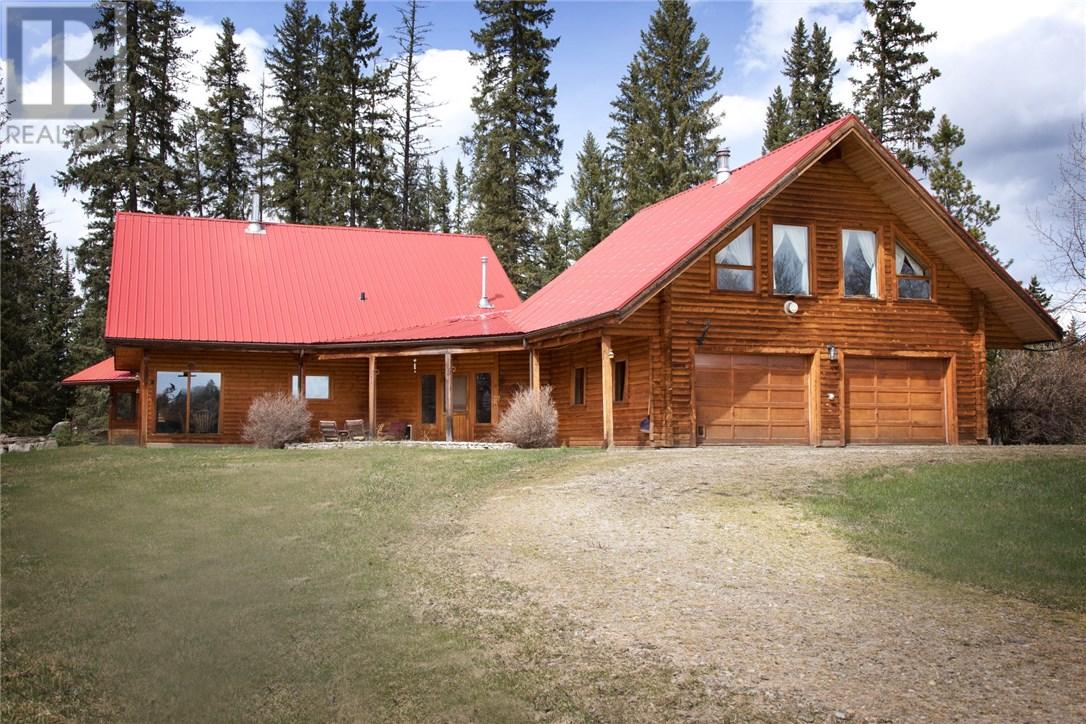
Ranch house and attached
garage, with guest house above garage, looking north
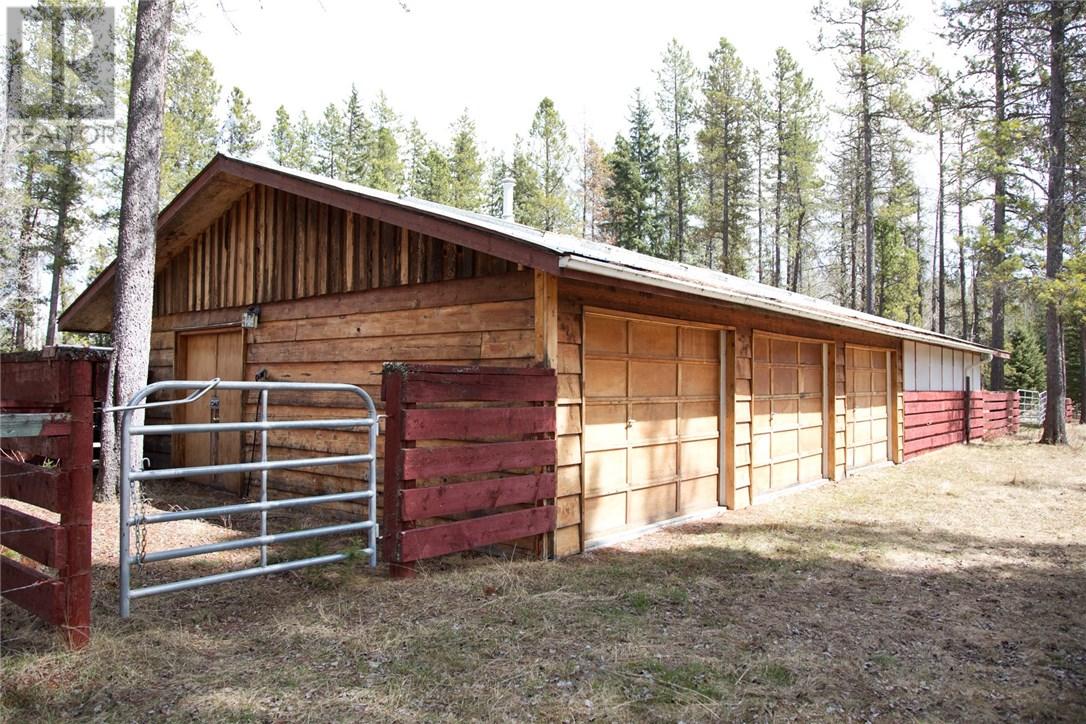
Heated shop / 3-car garage, with open machinery storage at far
end, looking north-east
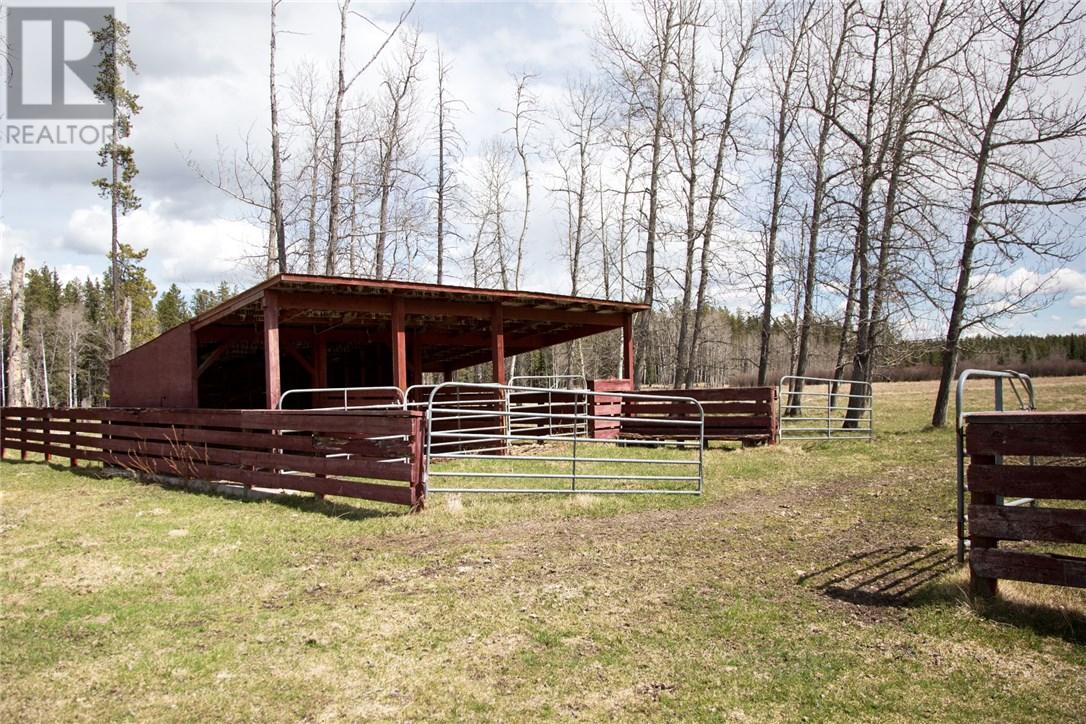
Calving pens on side of Hay Barn, looking north
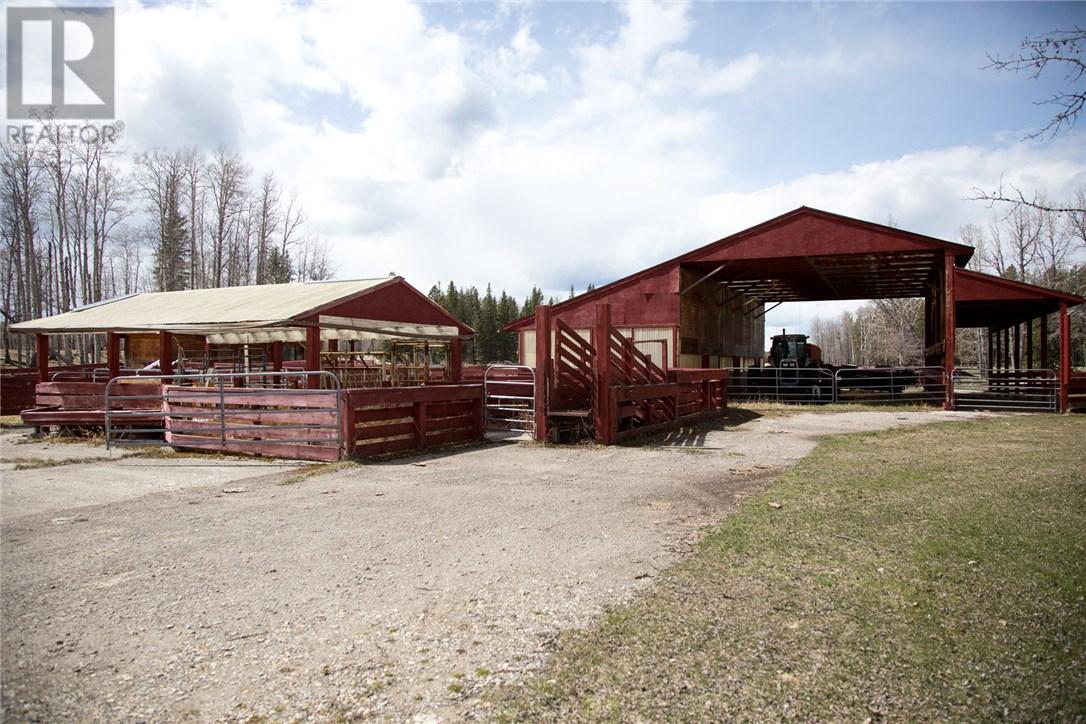
Covered working chute at left, hay barn at right, looking west

Bunkhouse with maternity pen at rear, heated, looking south from
hay barn and calving pens
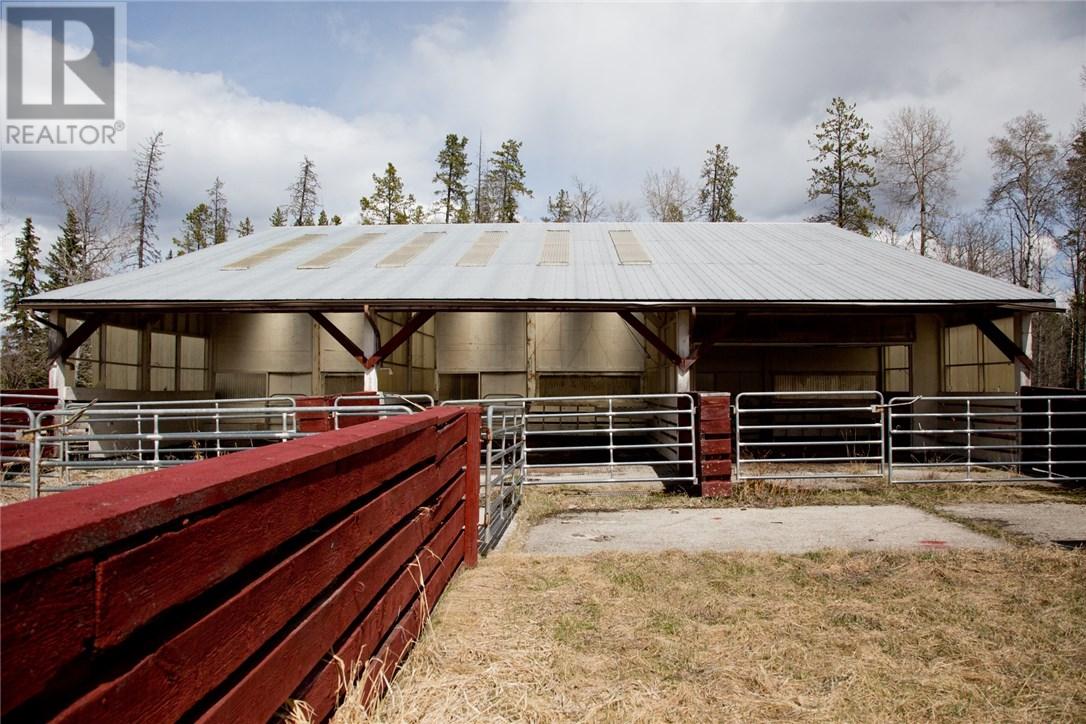
View of calving pens from Bunkhouse, looking north. Eat, sleep,
play solitaire in heated comfort while watching calves being
born.
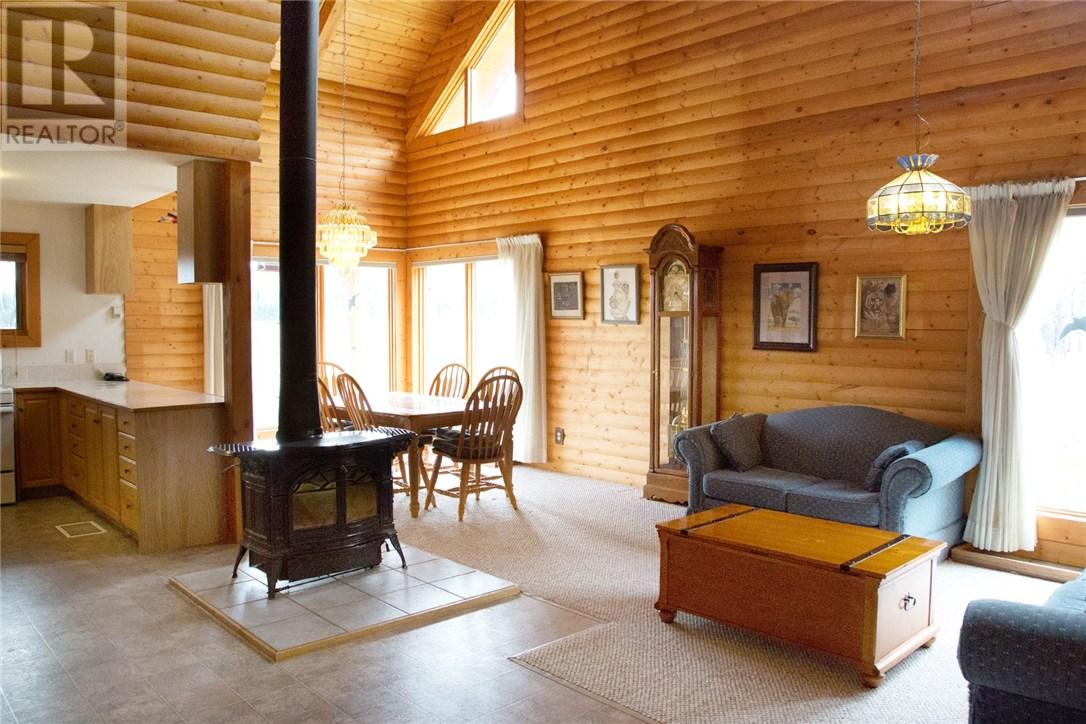
Dining room interior, looking southwest, kitchen at left, living
room at right
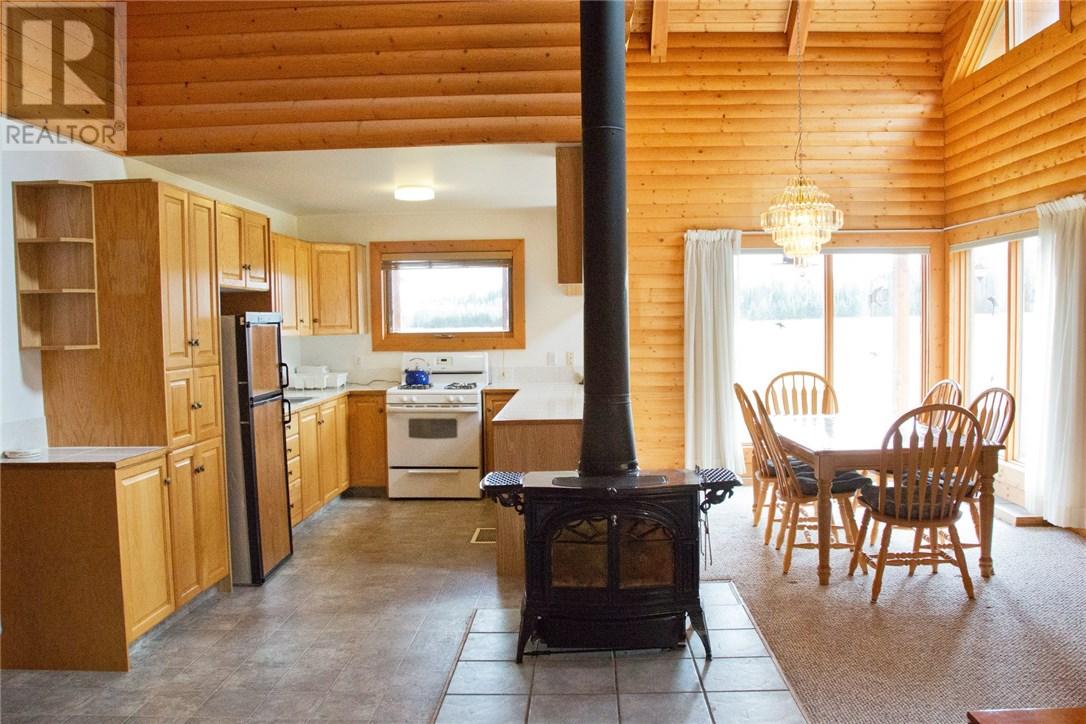
Kitchen on left, dining room at right, looking south

View into kitchen from dining room, looking southeast
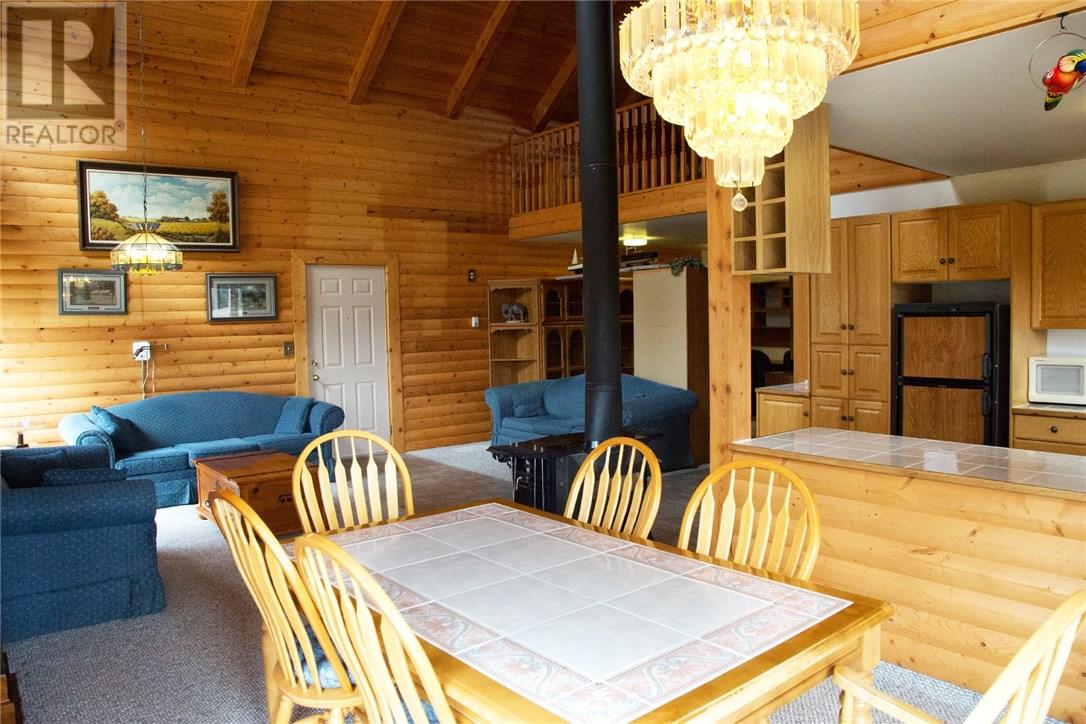
View into living room from dining room, looking north
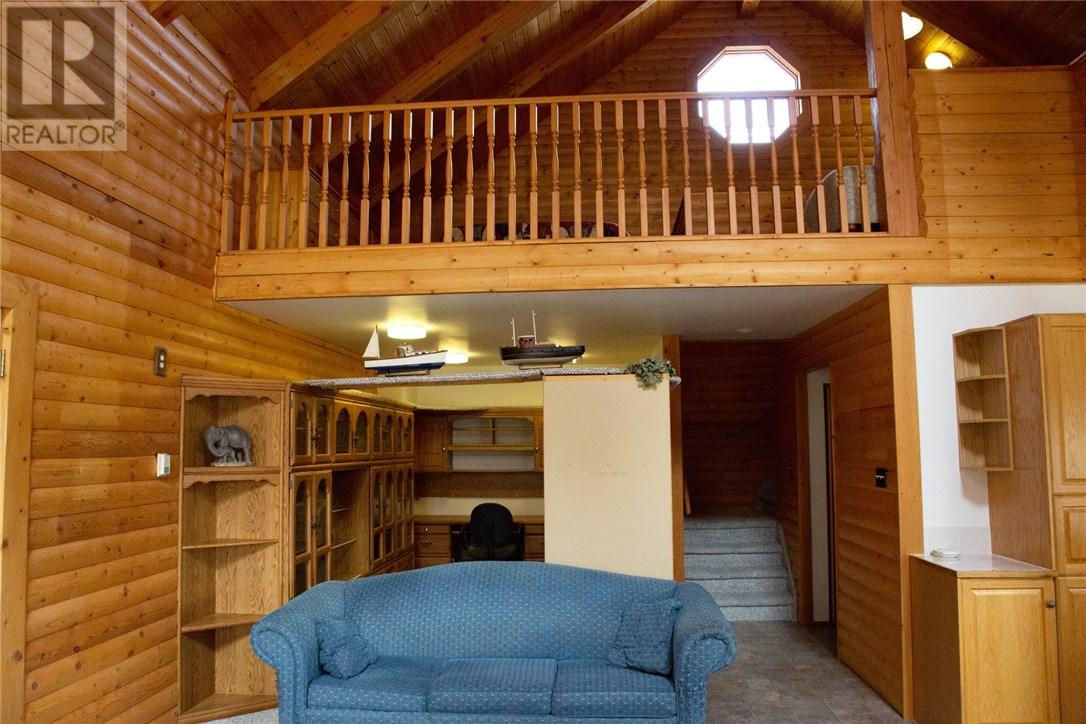
View from living room into office / den with loft bedroom above,
looking east
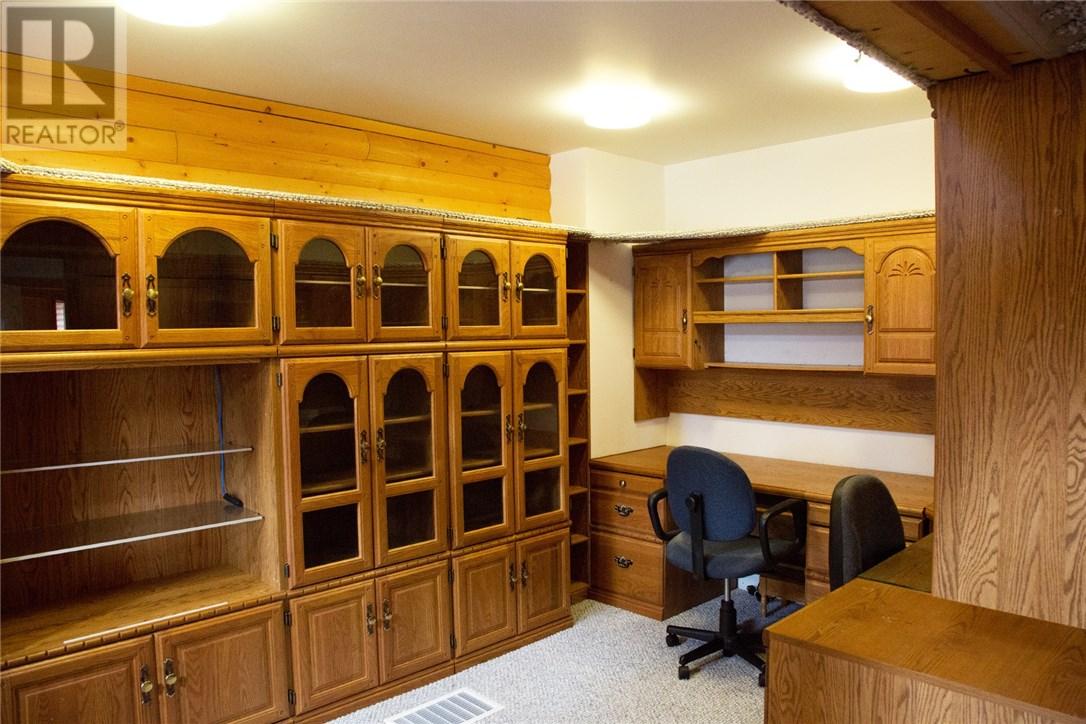
Built-in walnut cabinets / bookcases in office / den, looking
north
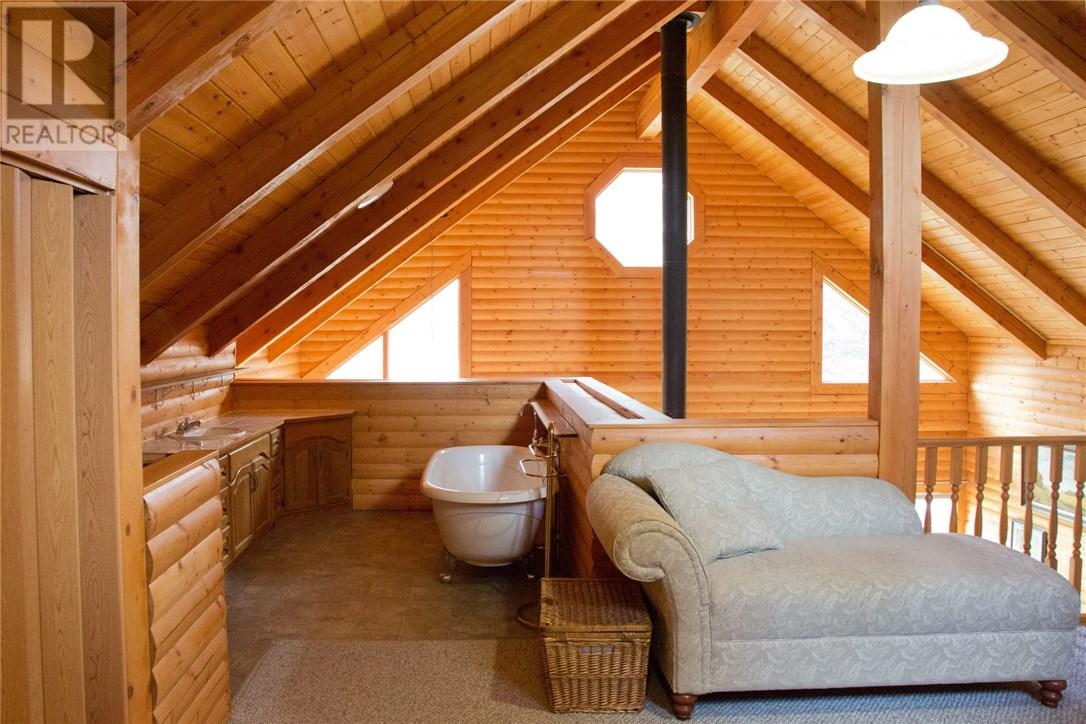
View over dining and living rooms from loft bedroom, looking
west
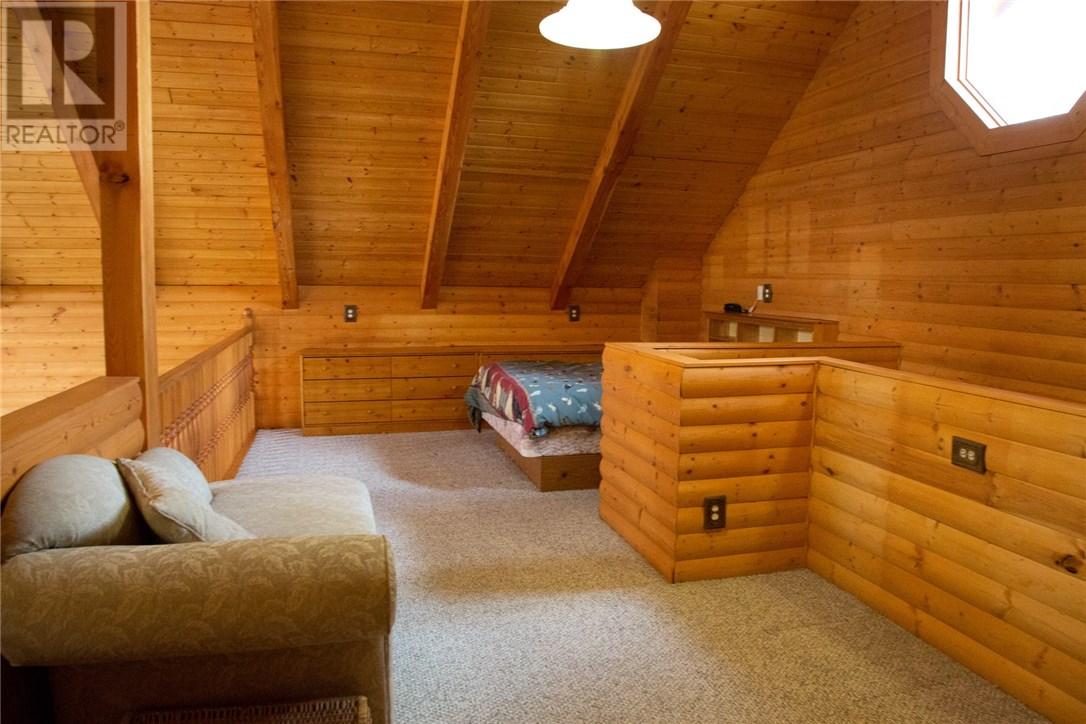
Loft bedroom, looking northeast
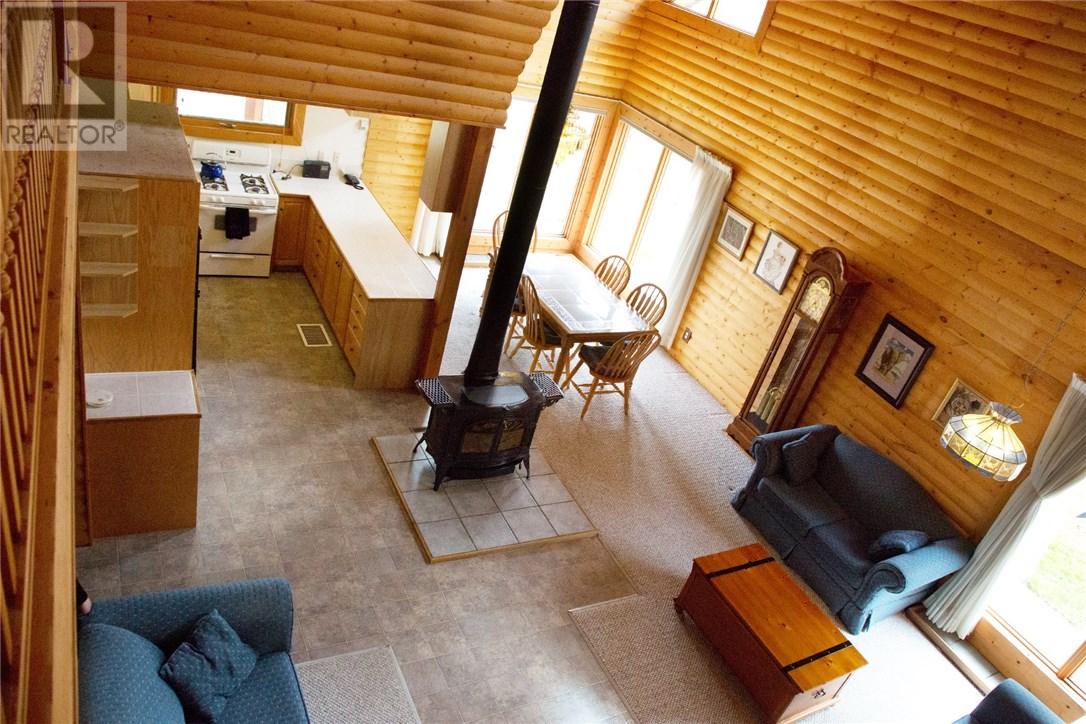
Another view overlooking dining room from loft bedroom, looking
southwest
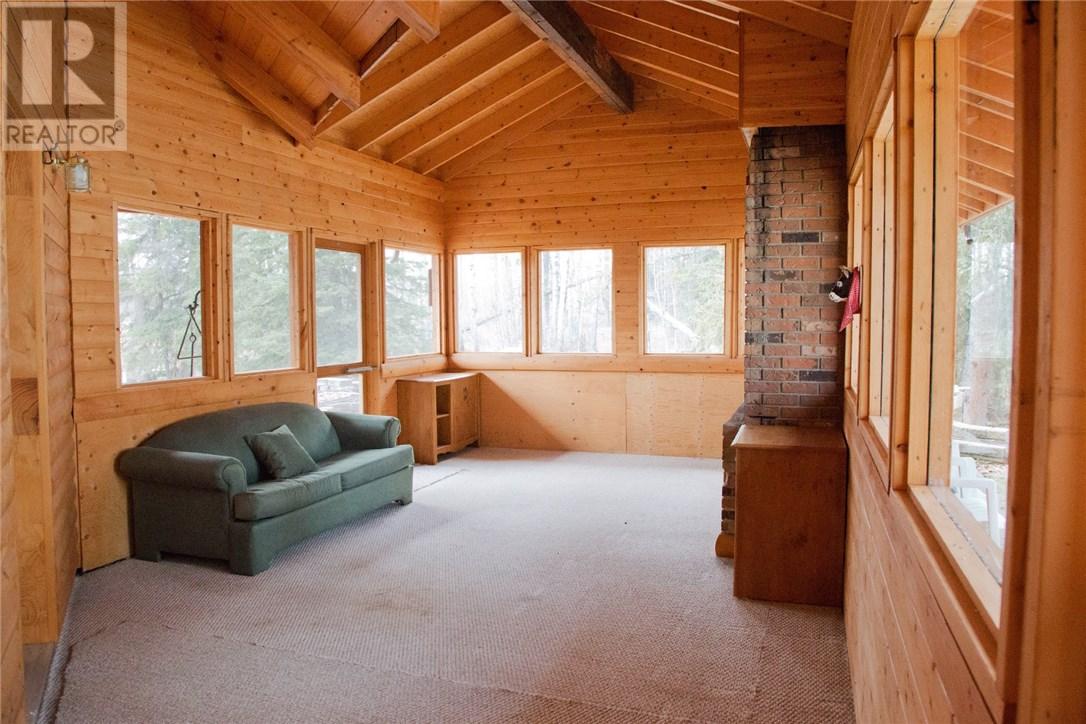
Interior of screened porch / summer kitchen, with brick BBQ at
far right , looking west
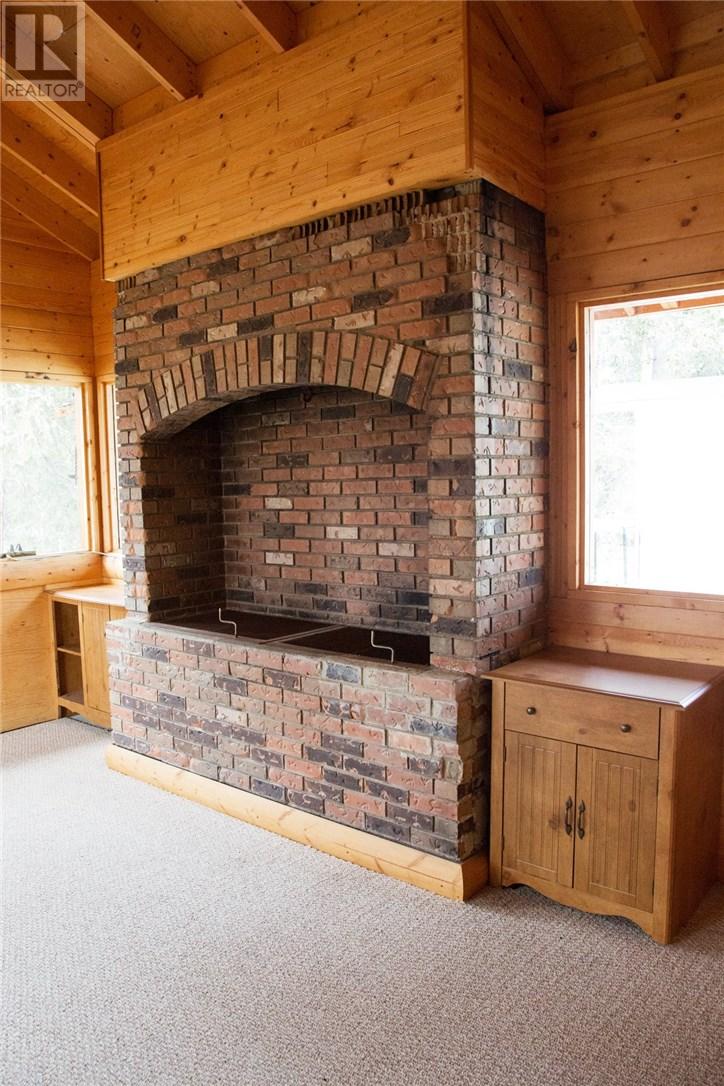
The built-in brick BBQ
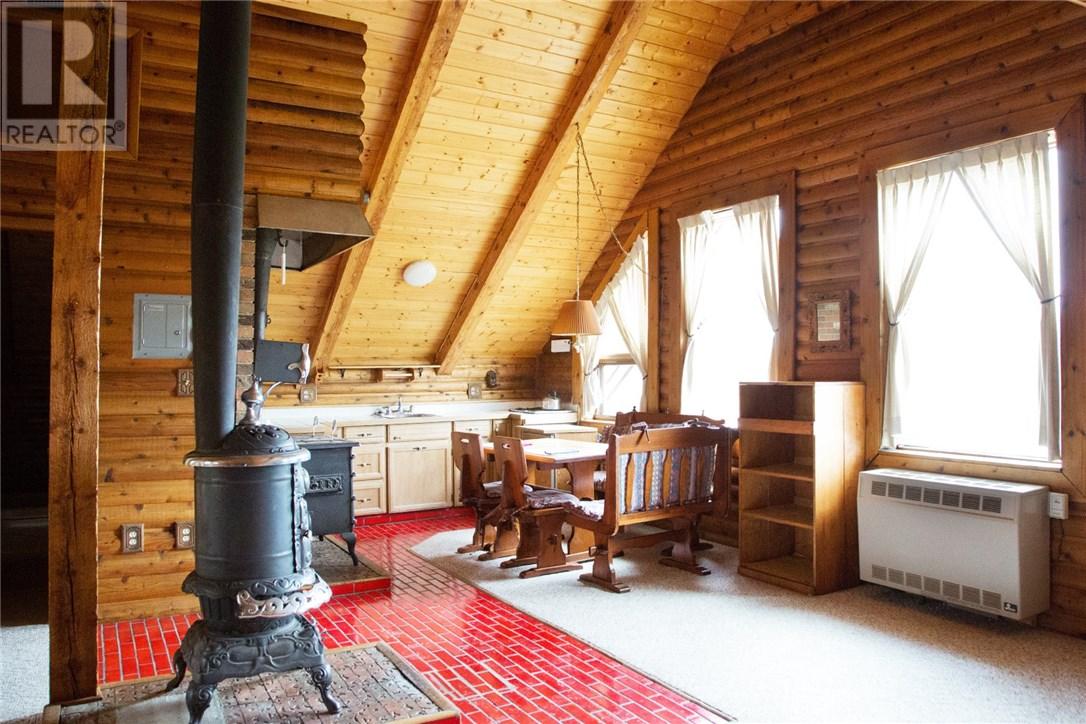
Guest house kitchenette on left and living room on right,
looking south
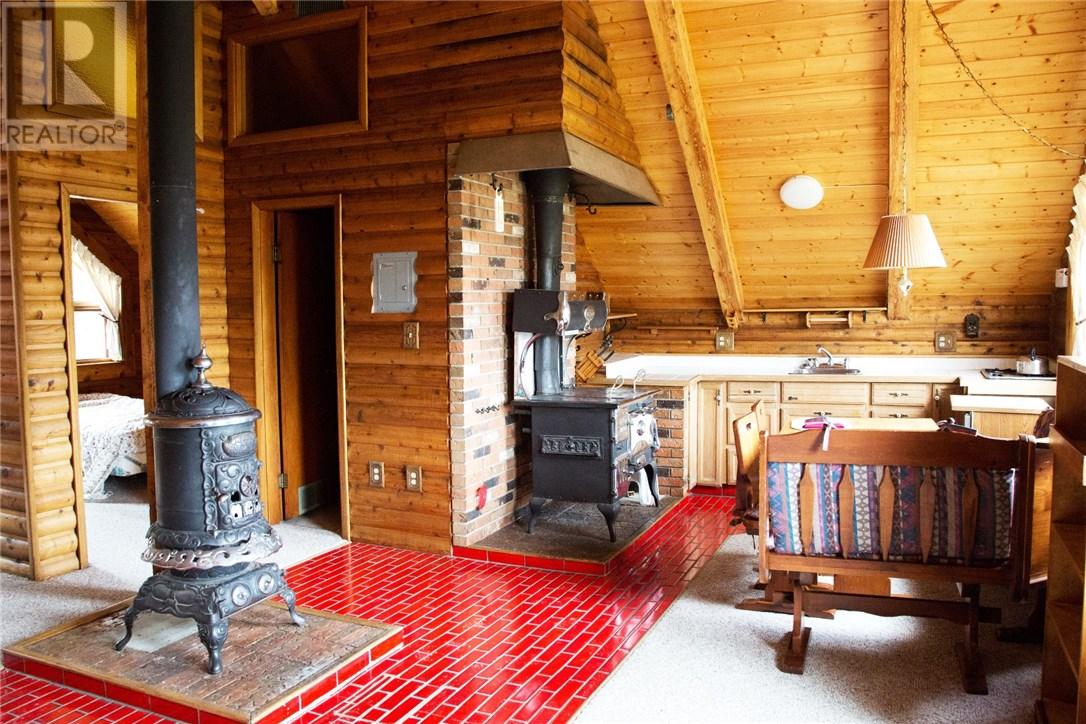
Guest house kitchenette from living room, looking east
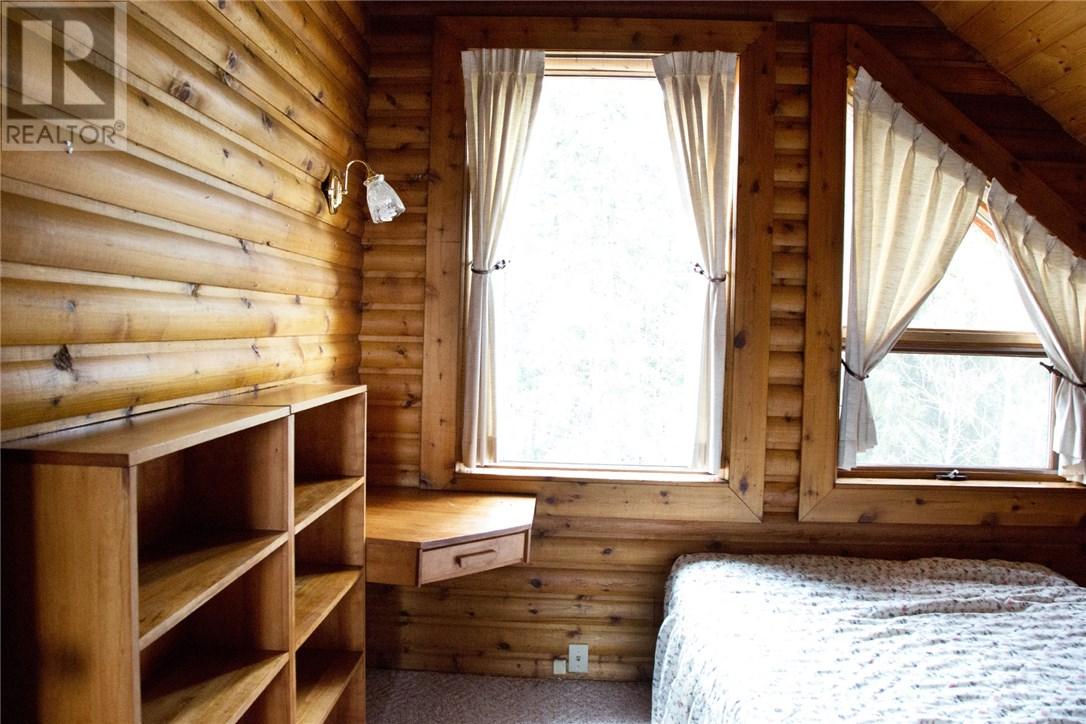
Guest house bedroom, looking north
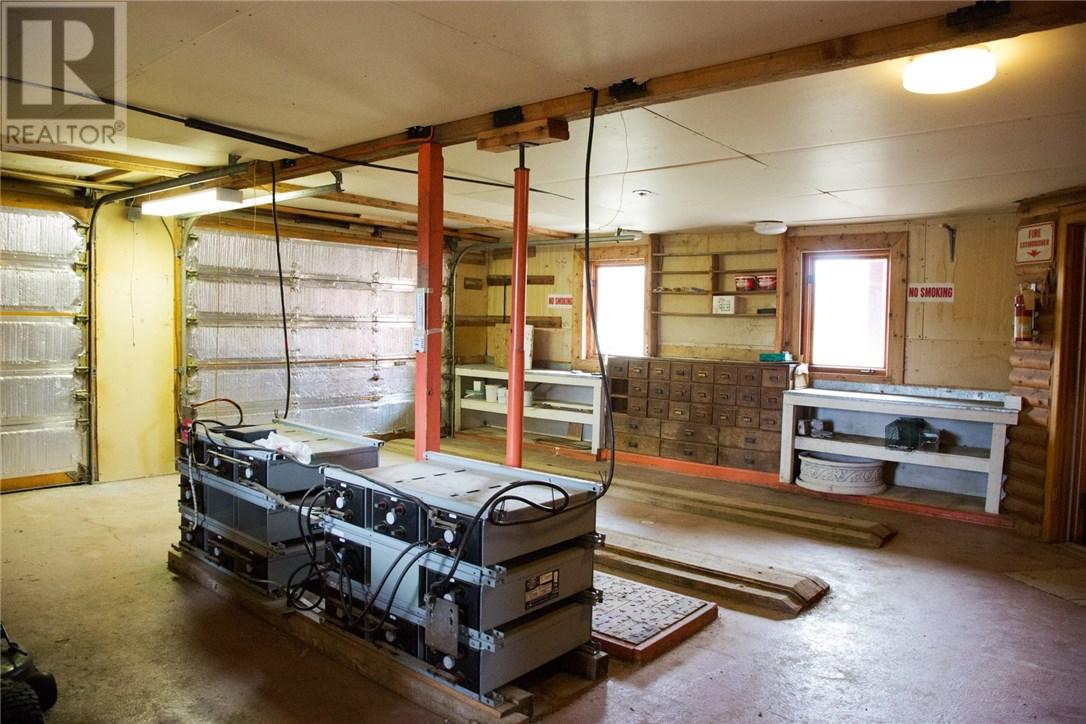
Inside 2-car garage with solar power system batteries in
foreground, looking west
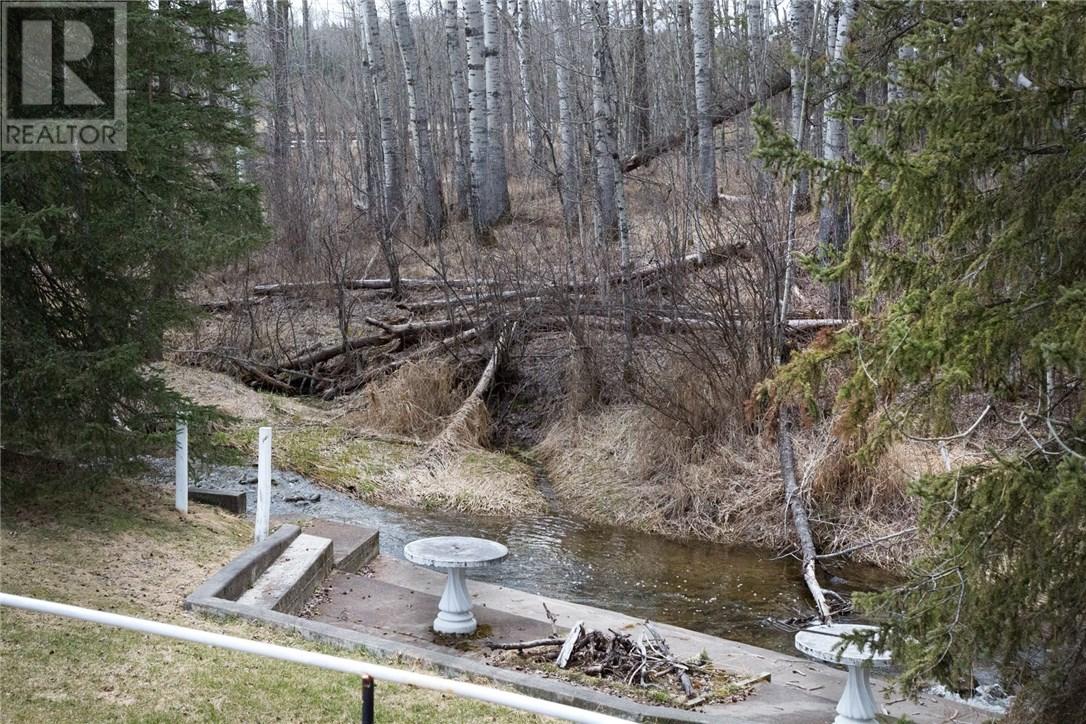
Patio, tables, and fire pit beside year round stream, on west
side of house
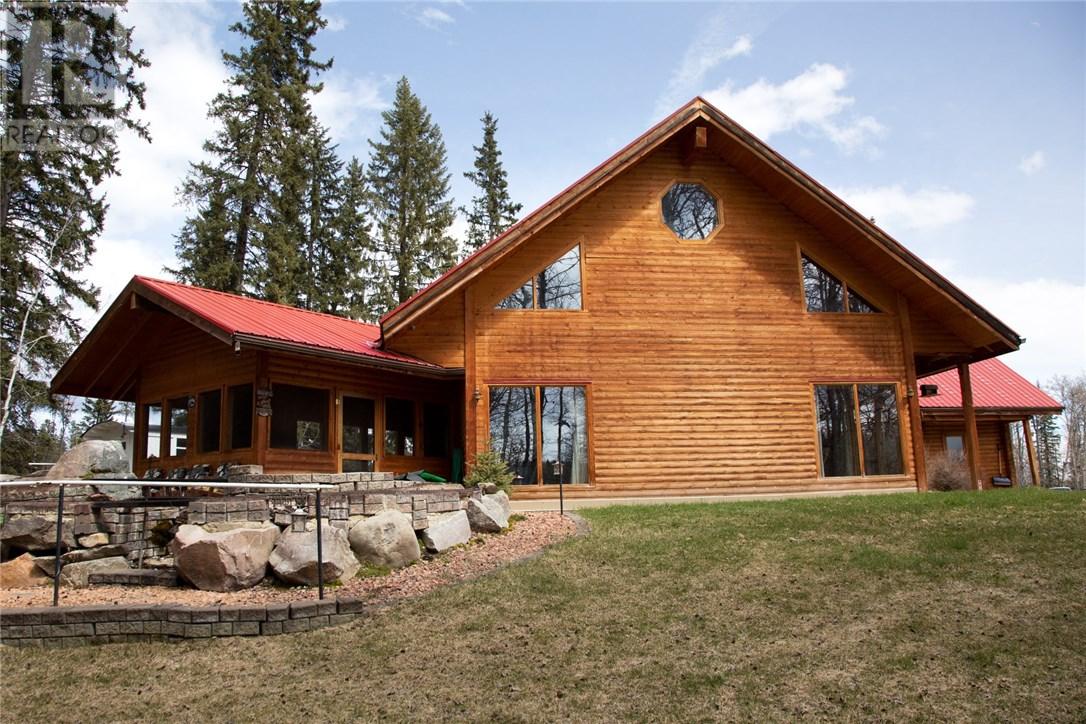
West side of house with screen porch at left, living and dining
room at right, rock garden and
garden railway in the foreground
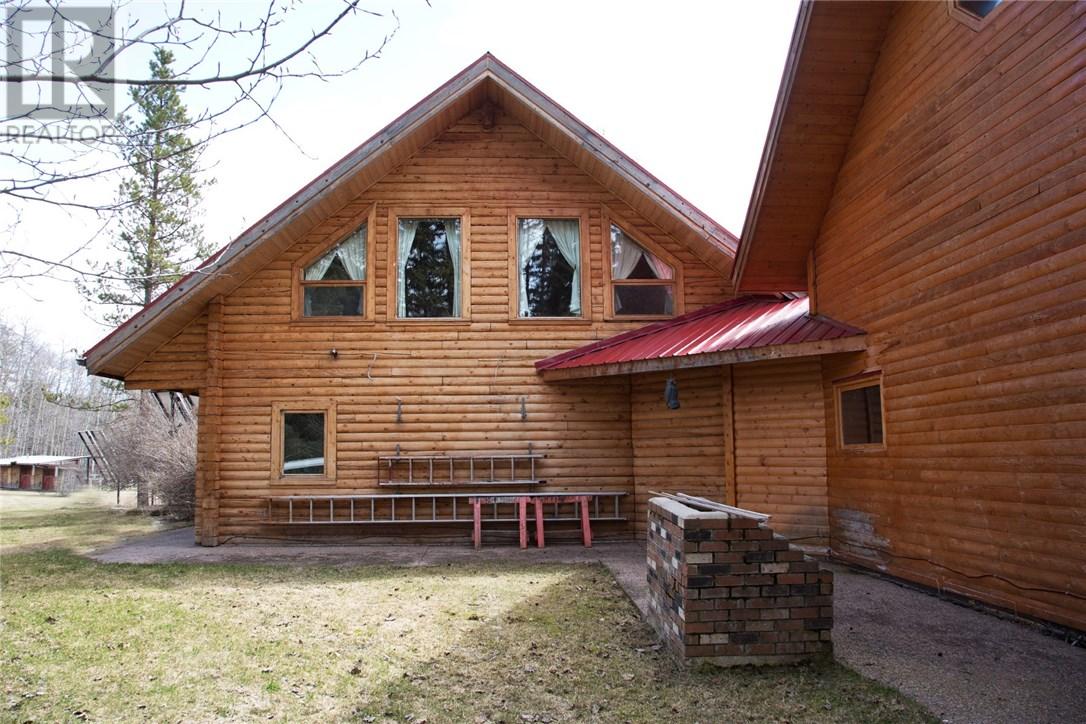
North side of guest house / garage

South side of guest house / garage
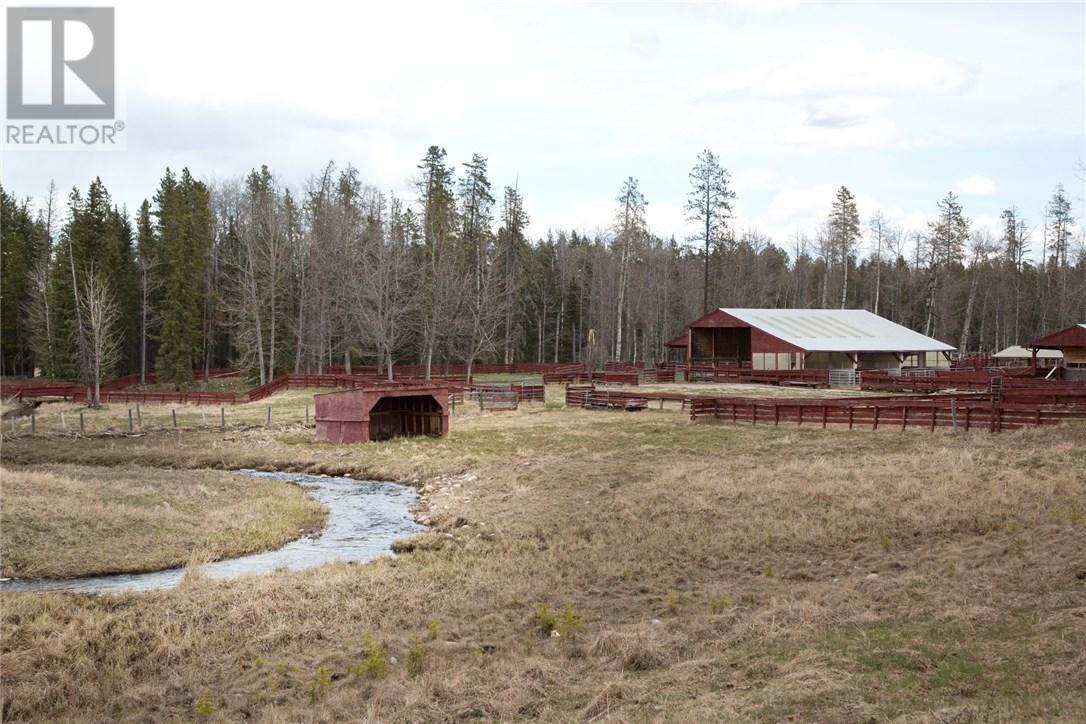
View of barns and corrals from lawn east of house, looking
northeast
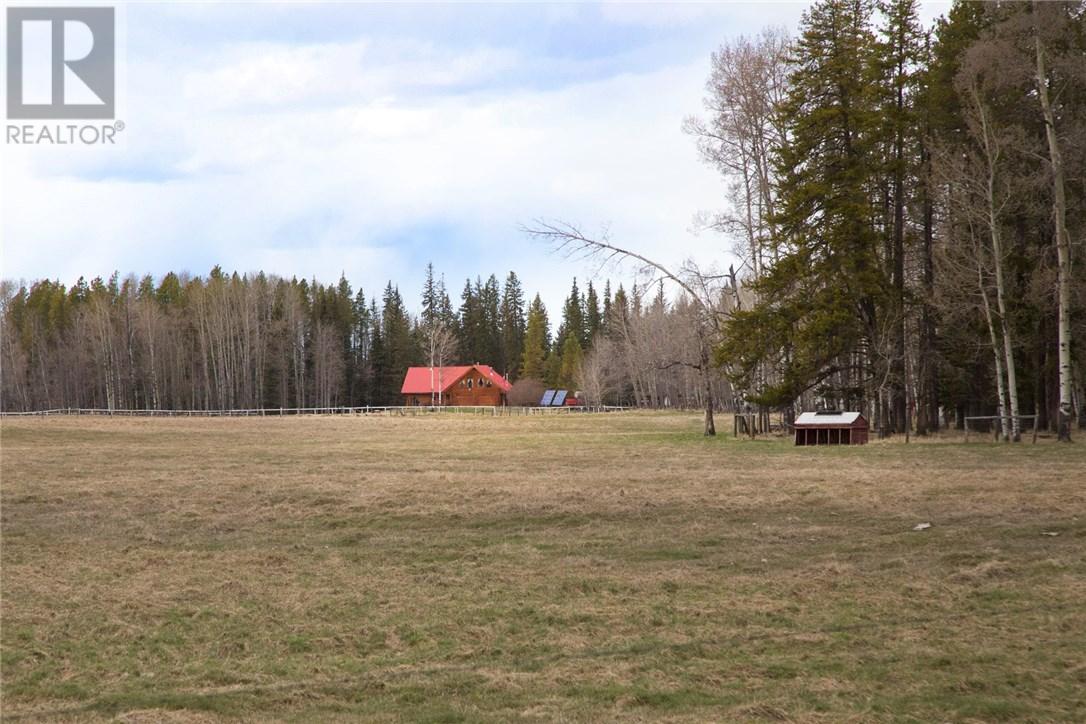
View of house and lawns from south pasture, with solar panels to
the right of the house, looking north

Completely off the grid with solar power and natural gas heat.
Photo by the Owner
Scroll down past the critters and machines to
learn how to deal with industrial neighbours in a rural setting.
 THE
CRitters In My Life
THE
CRitters In My Life
They kept me sane during
the tougher times. The unconditional love from a dog is amazingly
therapeutic. Cats are a different experience but mine were quite
loving and loveable. There were also chickens, ducks, geese, and
goats from time to time, myriad birds and 4-footed
wildlife co-existed with me at the ranch. I miss them all.
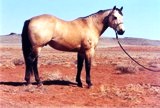
<== Chuckles 1972 - 1995
(*
= Rescued Animal)


Benjamin 1953 - 1960
*Simon 1954 - 1962



* Cana 1970 - 1983 *
Charlie 1982 - 1984 *
Chief 1971 - 1984


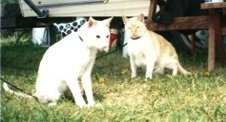
Chulalonkorn and
Rama 4th #1
Chulalonkorn and Rama 4th #2
1971 - 1983
1983 - 2005


*Socks 1989 - 2000
* Missus Socks 1989 - 1998

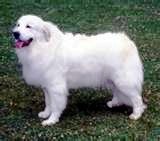
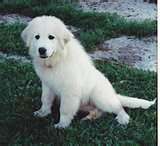
Cochise 1975 - 1987 * Sancho
#1 1983 - 1995
* Zara 1987 - 2001
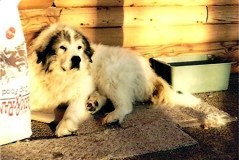
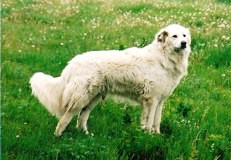
Rocky Bear 1995 - 2007
* Sancho #2 1999 - 2012
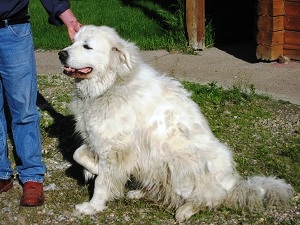
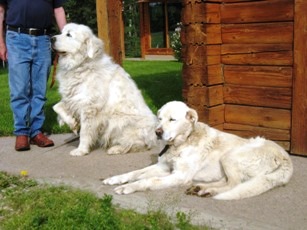
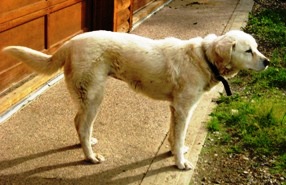
* Magnus 2010 - 2015
Magnus and Lady 2012
* Lady 2012 - 2013
 The Vehicles In My Life
The Vehicles In My Life
I haven't driven a car since 1984,
and I miss the freedom to go where I wanted, when I want to. The
memories of the miles and milestones in the cars are easy to bring back
when I need them, by looking at the tiny photos on this page. Ah,
the stories I could tell.
These are the cars I actually paid for. There were company cars in
the early days -- a well worn Ford, a worse Chevy, a new Plymouth
Fury, a Holden in Sydney, and a dismal Datsun un Calgary. Many
memories here too, but not all are good ones.
My farm machinery is also shown at the bottom of the page - I drove
this stuff up to around the year 2000, and the MF1200 garden tractor
until 2014. After that, I stopped driving around in circles.

 

1959 Austin A55 Mk II
1948 MG-TD #1 1965
Austin A60 Stn Wagon 1967 MGB-GT



1973 Mustang II GT
1947 MG-TC
1982 Chevy S10



1949 MG-TD #2
1976 Ford F250 and Trailer
1978 Eord Econoline

 
MF 1200 MF
285 and Hesston Stackmaker Caterpillar D-2



MF 210-4
MF 2645
MF 1805
 SURFACE RIGHTS
FOR RURAL LAND OWNERS
SURFACE RIGHTS
FOR RURAL LAND OWNERS
Some Ugly Truths About "Easy Money"
Oil,
gas, and mining companies may own mineral rights beneath the
surface of land owned or leased by other people. The subsurface
mineral rights owner has the right to explore and exploit their
subsurface holdings. That right is balanced by the land owner's
or lease holder's right to the use and quiet enjoyment of their
property; these are known as "Surface Rights".
Where these rights overlap, the two parties must come to some agreement concerning
the intrusion by the mineral rights holder onto the land
surface. The landholder often loses the use of a portion of his
landholding, and loses income derived from that land.
There is also general disturbance to the landholders operations,
dust, noise, and many other tribulations. The mineral rights
holder is expected to pay for the loss of income and compensate
for the disturbance for as long as the conditions exist.
A number of surface rights organizations (with websites) have
appeared and disappeared over the past 30 years. Government websites
have also evaporated so easy access to information on your
rights is difficult to locate.
Use your favourite search engine to find what is currently
available.
 DISCLAIMER
DISCLAIMER
The author of this
webpage is not a Lawyer nor a Land Agent. The opinions expressed
are based on 45 years as a rural land owner dealing with Land
Agents representing oil and gas, pipeline, seismic, and utility
companies. My experiences may not reflect accurately the
pertinent Laws and
Regulations in any particular jurisdiction. No warranty is
expressed or implied. This
information is presented as examples only and we accept no
responsibility for consequential loss or damages that may arise
from using the information on this webpage. You use this material at your sole risk and
responsibility. If you notice an error in facts, let me
know.
 WHO
WANTS TO RUIN YOUR LIFESTYLE ? WHO
WANTS TO RUIN YOUR LIFESTYLE ?
If a well is to be drilled or a facility or pipeline built near your residence, deeded land, or
leased land, you should receive a "Notice to Occupant" briefly
describing the proposal. Who is entitled to receive these
Notices varies with the type of facility, your distance from it,
and the particular regulations of your jurisdiction. Stay in
touch with your neighbours -- they may receive a notice and you
may not.
Read this document carefully. It will always present the most
benign, least intrusive case, and this may not represent
reality. It may contain
information vital to your operation or lifestyle. It may also
contain numerous omissions and errors of fact. For example, I have received 5
Notices on a single facility across a 4 year period. Two of then
claimed there would be no flaring of wells (this was a
compressor application, no wells were ever contemplated) but
failed to mention the flare stack for the facility. Two were for
doubling the compressor capacity but failed to mention the added
noise that such a facility would generate. When I complained to the contact
on the form, all I got was voice mail and he never returned my
call. There is no excuse for a careless or
misleading Notice to Occupant. Keep the oil company honest by a
critical review of all documents you receive and ASK QUESTIONS
if it doesn't compute.
 Surveyors
have a right to enter land without compensation, but the
residents expect the common courtesy of an introduction,
explanation of the purpose of the survey, and who and what it is
for, including contact information. Surveyors
have a right to enter land without compensation, but the
residents expect the common courtesy of an introduction,
explanation of the purpose of the survey, and who and what it is
for, including contact information.
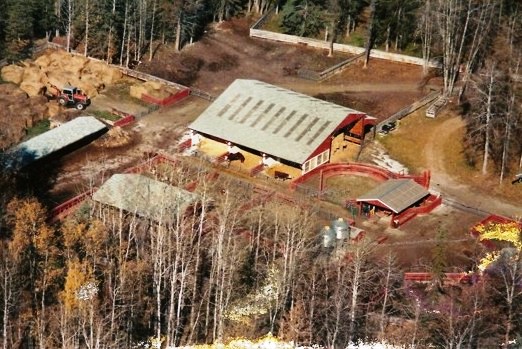  This is the barn in which surveyor's staked a well location on
my ranch. There is no excuse for this level of ignorance.
This is the barn in which surveyor's staked a well location on
my ranch. There is no excuse for this level of ignorance.
A surveyor bombing unannounced across private land on an ATV without
permission is rude and dangerous - the bulls in my bull yard
thought so and I passed on their comments when I caught up with
him.
Unfortunately, surveyors are trained to follow orders and to avoid
thinking about the world around them. Witness the surveyors who
staked a well center INSIDE my hay barn. Or the ones who staked
a Level 3 critical sour gas well 100 feet from my driveway, the
sole egress from my residence. Eventually, the oil company
president showed up to explain that he would have a helicopter
on stand-by to evacuate my family, my dogs? my cattle? in case
of an H2S leak or blowout - imagine a chopper pilot
descending through an H2S plume to rescue us! The surveyor's
then located the well center at the edge of an 80 foot cliff
- not a legal location and too small for a lease anyway.
Finally, they found a 4 acre flat spot far enough away to be
non-toxic. Three surveys, weeks of delay, expensive management
and technical time wasted, all because the surveyors did not
feed back the stupidity of the initial company requests. I'm not
making this up - it really happened!!
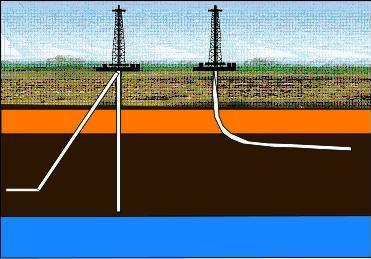 The moral of this long story is
that you DO NOT have to allow the lease to be placed where the
operator initially asks for it. With modern technology, they can
place the well almost anywhere and still reach their target.
Force the operator to consider your needs. If you don't take
part in this discussion, you will be stuck with the operator's
choice of location for half a century or more. The moral of this long story is
that you DO NOT have to allow the lease to be placed where the
operator initially asks for it. With modern technology, they can
place the well almost anywhere and still reach their target.
Force the operator to consider your needs. If you don't take
part in this discussion, you will be stuck with the operator's
choice of location for half a century or more.
 Seismic
crews will arrange
for a Land Agent to negotiate a fee, usually based on mileage or
number of seismic shotholes to be drilled (if any). Specifics
about methods (dynamite or vibrators), helicopter usage, access routes,
vehicular traffic (or not), clearing, cleanup, reclamation of shotholes, reclamation of artesian shotholes and stream
crossings, timing (after harvest, after calving season), and
other concerns must be in writing. Land owners and lease holders are
not required to agree to a standard agreement unless it covers
ALL your concerns. Be sure to add your concerns to the standard agreement
when needed. Seismic
crews will arrange
for a Land Agent to negotiate a fee, usually based on mileage or
number of seismic shotholes to be drilled (if any). Specifics
about methods (dynamite or vibrators), helicopter usage, access routes,
vehicular traffic (or not), clearing, cleanup, reclamation of shotholes, reclamation of artesian shotholes and stream
crossings, timing (after harvest, after calving season), and
other concerns must be in writing. Land owners and lease holders are
not required to agree to a standard agreement unless it covers
ALL your concerns. Be sure to add your concerns to the standard agreement
when needed.
In one case, I was asked if my cattle were afraid of
helicopters. I explained that it was only takeoff and landing
that bothered them, not the actual flight in the chopper. True
story.
Since the land and its use are relatively
undisturbed, and the operation is short-lived, compensation is
not high unless there are serious damages.
 Drilling Operations for oil and gas require a great
deal more effort during negotiation. The drilling operation will
take weeks or months. Drilling creates noise, odours, and
traffic, which in turn creates more noise, dust, and
interference. The well and its facilities will be on site for 25
to 50 years, and numerous workover events will take place over
the life of the well. There is also the risk of spills, leaks,
blowouts, and motor vehicle accidents for the life of the well.
The area needed for a well site is usually 4 to 5 acres plus use
of an existing or new access road.
Drilling Operations for oil and gas require a great
deal more effort during negotiation. The drilling operation will
take weeks or months. Drilling creates noise, odours, and
traffic, which in turn creates more noise, dust, and
interference. The well and its facilities will be on site for 25
to 50 years, and numerous workover events will take place over
the life of the well. There is also the risk of spills, leaks,
blowouts, and motor vehicle accidents for the life of the well.
The area needed for a well site is usually 4 to 5 acres plus use
of an existing or new access road.
 If
it looks smooth and green, someone made it that
way.
Guess where they want to place the wellsite.
Yup --
right in the middle of that nice pasture. If
it looks smooth and green, someone made it that
way.
Guess where they want to place the wellsite.
Yup --
right in the middle of that nice pasture. 
If the mineral rights are owned by a government (provincial,
state, federal) the oil company must apply for a mineral surface
lease and pay the government a royalty on the value of the
production. The land owner or lease holder gets nothing from the
production, but will be compensated for the surface area used,
plus some other considerations. If the mineral rights are held
by the landowner or another third party, the oil company must
negotiate with that person as to royalties.
For the record, we have been
blown off our place twice because of sour gas releases from oil
wells- each a result of human error or faulty equipment
assembly. Neither of the companies even admitted that the
incidents had occurred (I have photos) and the companies did not report them
to the regulators (I did), nor did they offer any compensation. We also put up with "non-toxic"
levels of H2S for over 3 months due to a poorly managed sour gas blowout
more than 50 miles away. And there was the rig fire that
blackened the snow (and my house) with soot for two miles in
all directions, and the floods, each time an oilfield access road
washed out, and the off-site sump that leaked toxic oil-based mud
into my creek for 26 years (still not reclaimed), and ..... well you
get the point.
For those who are not aware, H2S
(or sour gas) is hydrogen sulphide, a by-product of some oil and
gas production operations. H2S is heavier than air and sinks
into valleys and low areas, unless blown away by wind. H2S
smells awful and if you can smell it, leave the area
immediately. If the smell goes away, either the problem has been
fixed or you are about to die! The occupational exposure limit
is 20 parts per million for 15 minutes, then you go home for 48
hours to recuperate; 200 parts per million will knock you
unconscious, and 700 parts per million is immediate death. The
residential exposure limit for H2S is supposed to be ZERO - that
is, no H2S is allowed to go beyond the lease boundary. Good luck
on that one.
To reduce risks from H2S, the gas is supposed to be captured and
pipelined to a processing plant. Where this is uneconomic, H2S
will be flared (burned), creating sulphur dioxide (SO2) and
water vapour. SO2 is less dangerous than H2S but still smells
bad and has long term detrimental effects on the respiratory
system of humans, cattle, and wildlife. Other by-products, such
as benzene, are relatively odourless, but can still make you
sick after sufficient exposure. The only cure is for the oil
company to capture all gases and put them into a pipeline.
Naturally, they will resist doing this unless extreme pressure
is brought to bear upon them. Their
motto is "The solution to pollution is dilution", hoping that
the wind or rain will carry the problem away.
Compressor Sites
and Gas Processing
Facilities also need a surface
lease similar to that needed for a wellsite. But wellsites are
pretty quiet compared to a compressor. Three 1600 horsepower
compressors will sound like a jumbo-jet during takeoff, all day,
all night, every day, all year long. If you are within a mile of this, you will notice,
within 500 feet, you will go stark raving mad. A "Noise Impact
Assessment" (NIA) will be needed before construction and
predicted sound
levels must be below specific limits. If there are other noise
sources nearby, an NIA for the combined facilities is required.
NIAs
may be cooked to keep
the predicted levels below these limits and always represent the
most optimistic weather and ground conditions. It will always be
noisier than predicted, especially under adverse weather
conditions. See MORE
at the end of this page.
After the fact remediation is expensive
and slow to arrive. It took me three years of constant
harassment to get the compressor next door to my ranch tuned up
enough to meet regulations. Be forewarned.
 Pipeline rights of way, like powerlines, are placed on an easement that restricts building
close to the line. The setback will vary with the size and type
of fluid pushed through the line. Since the line is buried, the
surface use, except as to buildings, will return a few years
after laying the line. Compensation is based on that loss of use
and some for general disturbance during construction. The actual
reclamation after construction is problematic - many farmers and
ranchers have had serious concerns trying to obtain compensation
for poorly reclaimed land.
Pipeline rights of way, like powerlines, are placed on an easement that restricts building
close to the line. The setback will vary with the size and type
of fluid pushed through the line. Since the line is buried, the
surface use, except as to buildings, will return a few years
after laying the line. Compensation is based on that loss of use
and some for general disturbance during construction. The actual
reclamation after construction is problematic - many farmers and
ranchers have had serious concerns trying to obtain compensation
for poorly reclaimed land.
Sour gas and high vapour pressure
lines have fairly large Emergency Planning Zones (EPZ) that can
extend well beyond the pipeline setback distance. These will
reduce the value of your property and limit where you can build.
Plan ahead for future development.
 SURFACE
LEASE and PIPELINE LOCATION
SURFACE
LEASE and PIPELINE LOCATION
 BEFORE
discussing compensation with a Land Agent, first negotiate the
location of the proposed operation. If you discuss compensation
first, you have tacitly agreed to the oil company's location and
the compensation is related to that specific location. Be sure
the location is suitable to your operation and as far from your
residence as possible. With current technology, an operator can
reach its target from anywhere on a given quarter section. BEFORE
discussing compensation with a Land Agent, first negotiate the
location of the proposed operation. If you discuss compensation
first, you have tacitly agreed to the oil company's location and
the compensation is related to that specific location. Be sure
the location is suitable to your operation and as far from your
residence as possible. With current technology, an operator can
reach its target from anywhere on a given quarter section.
This rule also applies to
"Consent of Occupant" agreements for wellsite or facilities on
adjacent lands, but within a short distance where consent of
occupant is required. I got caught sleeping on this once, when
the Land Agent told me that the compressor would be built on the
south west corner of the lease. This was not put in writing. The
compressor was built on the northeast corner, as close to my
residence as was possible. It took three years to get the noise
level below regulatory limits, and I can still hear the roar in
the early morning and early evening. Verbal promises are
worthless.
Before agreeing to compensation, be sure the survey plan is
attached to the agreement and corresponds to what you think you are agreeing to.
If there is no survey plan DO NOT SIGN anything. If the company
refuses to provide a survey plan, go immediately to a Right of
Entry Hearing, where a survey plan is required by law.
There are
many good reasons for a landowner to require a Right of Entry
Order instead of a private agreement with an oil company. They
are easier to find, easier to enforce, easier to arbitrate, and
easier to modify than private agreements.
 SURFACE LEASE and PIPELINE COMPENSATION
SURFACE LEASE and PIPELINE COMPENSATION
An
oil company drilling on privately owned or leased land needs to
negotiate a surface lease agreement with the land owner or
lease holder. The compensation is based on an upfront payment and an
annual fee until the wellsite is properly abandoned and
reclaimed to the satisfaction of the appropriate government
agencies. The table below itemized the specific items that need
to be negotiated. However, keep in mind that it is the total
compensation package that matters in the end. Dollar values
shown below are 2010 averages.
The sum of Items 1 through 6 is
to be paid at the time of signing the surface lease agreement
with the energy company and covers the first year of operations. No machinery
moves on the lease until the cheques clears the bank.
The annual compensation, sometimes called the "annual rent", is the sum
of items 4 and 5. This amount should arrive automatically 20 to
30 days before the anniversary date of the lease agreement. If
the payment doesn't arrive on time, raise hell with the surface
land administrator in the oil company. If a company goes
bankrupt, your lease compensation goes on the Receiver's list of
debt's owing, and you may get nothing for a while. When a new
company takes over the lease, you may get paid immediately or
you may want to negotiate a whole new agreement.
EXAMPLE: 4 acre lease plus 1 acre access road, total 5 acres
1. Entry Fee $500 per
acre times 5 acres = $ 2500
2. Land Value $3600 per acre times 5 acres
= $18000
3. General Disturbance
= $ 4000
4. Loss of Use $500 per acre times 5
acres = $ 2500
5. Adverse Effect
= $ 4000
TOTAL 1st year compensation
= $41000 including Entry Fee
ANNUAL COMPENSATION: Sum of items 4 and 5 = $ 6500 per year
For a pipeline right-of-way, only items 1 and 5 are usually
paid, but damages may be claimed against the company.
Damages may be paid if demonstrated, for example damaged roads
or fences, culverts, cattle guards, lost cattle, or failure to properly renovate and
reseed a lease, right of way, or temporary workspace to the satisfaction of the land owner.
 Alberta 2009 Sample Data Sets and
Definitions
Alberta 2009 Sample Data Sets and
Definitions
Alberta Ag once provided online
maps for the components of lease and pipeline agreements. Their
purpose was to provide price transparency for
rural land owners to aid them in negotiating a fair deal. The webpages are no longer
active but are listed here to show what used to be available.
One can only speculate as to why the maps disappeared.
List Of
Obsolete Links to maps of Alberta showing:
land value for surface lease per
acre
land value for pipeline right of
way
general disturbance payments paid per well site
loss of use payments paid
adverse
effect payments paid per well site)
Price transparency, suggested by
the publication of the above links, was a bit of fiction anyway. The data used
in the maps was
from a database developed by W. H. Marriott
and Associates for use by Land Agents through subscription. The
database is no longer visible on the Internet. Posting of prices
was voluntary. Self-interest on the part of individual Land
Agents would reduce the likelihood of posting freely negotiated high
values. No new data have been published since the 2009
data went missing,
except in SRB Orders in Alberta and BC.
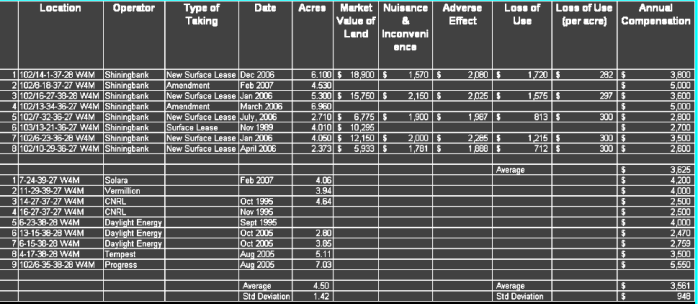
Sample listing from the Marriott database. Land Agents have
access to this kind of data -- landowners do not.
The
Canadian Association of Landmen (CAPL) published two articles
in their magazine (May and October 2010) about the Marriott
database. The
articles indicated that CAPL members were in favour of such a
database as it "would lower the prices paid for compensation" and
reduce costs to the oil companies.
Do CAPL members still share compensation values paid to
landowners? If so, is that a breach of privacy laws? Or a
breach of the Canada Competition Act?
Land Agents have access to
large in-house data sets of compensation values paid out over
the years, plus word-of-mouth knowledge via personal networking
that land owners do not have access to. Land Agents do not
show "comparables" to the landowners, like real estate agents do.
It is a very one-sided negotiation. Land Agents are not above
stretching the truth, although their Code of Ethics suggests
that they shouldn't do this. I know my compensation agreements
have been discussed among Land Agents working for different
companies - this is a breach of privacy since no one has the
right to discuss my private financial affairs with anyone,
period.
To find some compensation awards by the various provincial
Surface Rights Boards, Google "Surface Rights" "Compensation"
"Comparables", and see what you get.
 FIVE YEAR REVIEWS
FIVE YEAR REVIEWS
Some jurisdictions provide for an automatic review of the
"annual rent" every 3 or 5 years. If this is not a regulatory
feature where you live, put the review into the agreement. Think
of what a dollar could purchase 25 years ago !
In many cases, oil and gas companies fail to give the required
notice or give notice claiming that no change in compensation is
warranted. Since inflation of agricultural costs increases by 4
or 5% per year, this statement is clearly untrue. The landowner can request the review and if the
company does not respond appropriately, the landowner can apply
to the Surface Rights Board for a review, and it will force the
company to attend and respond. While the 5 year review is mandatory in Alberta and BC (3
years in SK), there is no penalty for non-compliance, so it is
up to land owners to force the issue.
One of my
agreements was dated June 1981, so it should have been reviewed
before June 2011. The oil company, for reasons unknown, claimed it was dated
November 1979 so no review was needed until the end of 2014,
even though they gave notice of the review in November 2013.
After 9 months of non-response to my emails, I threatened to
apply to the Surface Rights Board to correct the date of the
agreement and to update a 35 year old compensation package.
Amazing attitude adjustment!! We had an agreement in 24 hours, a cheque in 3 days,
retroactive to 2011, but no apology for their arrogant attitude
or the effort needed to get them on track.
 DEALING WITH A LAND AGENT
DEALING WITH A LAND AGENT
A
surface lease or pipeline right of way is an encumbrance on your
land and affects its value forever. Some people think oil field
revenue enhances a property's resale value because of the cash
flow it represents. This value is offset by the odors, noise,
dust, traffic, loss of use, and adverse effect of the lease. The
cash may look good now, but even with compensation reviews every
5 years, that cash flow won't be enough 20 years down the road,
especially if you want to subdivide or build new structures or
change the primary use of the land. And you pay tax on all the
compensation, including the upfront cash.
Land Agents, often called Landmen regardless of gender, come in
many flavours, from the "Nice Boy Next Door" to "The Cowboy",
from the "Farmer Charmer" to "That Arrogant Bastard". Most field
agents are male; many surface land administrators in the office
are female. They work for, or are contracted agents for, the energy
company. THEY DO NOT
work for you ! They are your adversary and don't forget it.
Land Agents understand the agreements, surface land regulations,
and negotiating tactics better than most farmers and ranchers.
They appear to be in a position of power and can be
intimidating.
You know your land, your operation, and your long tern goals far
better than the Land Agent. So you are equal but different.
The Land Agent will try to take charge of any meetings, and will
do his best to make you feel inferior. Be assertive, polite, and
state your case clearly. Take notes of what you said and what
the response was. Prepare for the meeting and research
costs and values in advance. Check out comparables as well as
you can via the internet and neighbours.
Most Land Agents believe they are working in the best interests
of both parties, and believe they are behaving in an ethical
manner. This is not really true - they have a boss and he has a
boss .... And they do "shade the truth", hide the
truth, make promises they can't keep,
and can easily misrepresent your negotiating position to their
employer. Many Land Agents are independent contractors paid by
the oil company to negotiate with you. They will not be hired
again if they do not follow orders, so don't expect too much
from a "hired gun". He often has no authority to change the
terms he was instructed to obtain. Land Agents who are employees
of the oil company are no better - their annual review, raises,
and bonuses will depend on how well they followed the "company
line".
A serious breach of ethics or privacy can be reported
to the Land Agent licensing agency (if one exists in your
jurisdiction), or to a Land Agents Association, or directly to
the Land Agent's boss. If you have a legitimate and serious
complaint, notify everyone in sight.
Document all your meetings, what was discussed, time spent, and
especially discrepancies in proposals between visits. These
notes will be helpful if a dispute arises before the agreement
is signed. You are entitled to be paid for your time. At a
Hearing, you could be awarded $50 per hour for your preparation and
research time. If you use a lawyer or representative or appraiser you might get some or all of their time covered, but
the time has to be very closely linked to the negotiation and
not on side issues.
  This is what you are trying to protect. This is what you are trying to protect.
Take the time
needed
to do it right.
The Land Agent will present an agreement
drafted by company
lawyers and will offer the lowest compensation that he thinks
might fly. DO NOT SIGN THIS DOCUMENT. It will not contain
all the terms and conditions you need to protect yourself and
your land. READ the links below:
Alberta
Standard Surface Lease
You will need time to assess the terms of the agreement and the
amount of the compensation. Take that time. Talk about the 5
components of the compensation separately - never accept the
first offer without a serious review of each component and the
overall compensation. They may have been a bit generous on one
item and a bit stingy on another - keep a balanced view.
Make
sure all the special terms you need are included in the final
draft, either in the body of the Agreement or as an Addendum. If
it is as an Addendum, the body of the Agreement must refer to
the Addendum and both the Agreement and the Addendum will need
to be signed by both parties. See the links immediately above
for possible clauses that you need to add, or add them all -
none of them will hurt you and may come in handy later.
If the Land Agent arrives without appointment, you may be busy
harvesting, planting, calving, or whatever - tell him to come
back at a more convenient time. If the Agent does not leave when
asked, he is trespassing and can be removed from your land by
the police. Don't use force yourself - dial 911 and watch him
skedaddle.
When convenient to your schedule, review the text of the
agreement, and the survey plan for road and lease layout. You
can do this with or without the Land Agent present. See how the
plan interferes with your operation, drainage, land/crop
quality, and proximity to residences and other buildings.
Request changes that make your situation better. For example, a
lease in the middle of your best pasture is inconvenient and
could be pushed to a bushy, rocky area close to the edge of the
property. The Land Agent does not have the authority to say "No"
without first discussing the changes with his boss.
You are being paid for the pipeline right of way or the surface
lease area specified on the survey plan, but there may be setback distances that prevent certain
activities some distance beyond these boundaries. This will
"sterilize" a large area of land and prevent building or
subdivision near the encumbrance, so think carefully about
future possibilities for your land. Although a lease may be
entirely on your land, the setback requirements may overlap onto
your neighbours land, causing him some possible financial loss
that cannot be compensated. Always check the setback distances
before you think you have a deal.
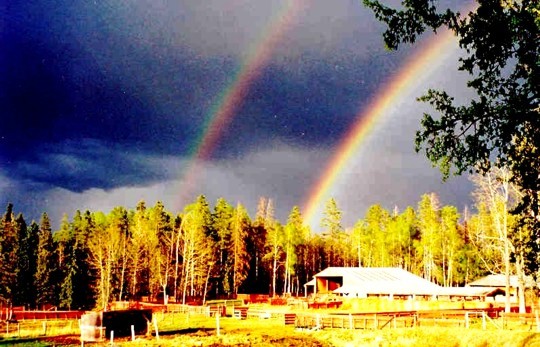 The only pot of gold at the end of the rainbow is your land.
It is your land and lifestyle - protect it. The only pot of gold at the end of the rainbow is your land.
It is your land and lifestyle - protect it. 
Always have the agreement reviewed by your own lawyer. That
might cost $400 but the original agreement will be very
one-sided. Get every concern of yours embedded in the final
agreement. If your requests are reasonable, the company has no
reason to refuse them. Such requests might include location and
locking of gates, quality and specifications for fences and
gates, grading and plowing of roads, seed quality, species,
weed control, berms for pollution control, and much more.
Do not give away any rights to the land other than those needed
by the company for its specific operation. For example, the
company does not need the right to offer the use of an access
road to another company - only the land owner has that right.
And just because one company has paid for an access road, other
companies do not get to use it for free. The agreement should
not include construction of other facilities on the same site,
without further negotiation and payment.
Verbal promises are worthless - all the terms of the deal have
to be in writing, in plain unambiguous language and in one agreement. Check the final agreement
carefully - "accidental" errors of omission have been known to
occur. Initial every page as you read them before you sign. Be
sure the survey plan has not been "revised" without your
knowledge. If the agreement is taken away to be signed by the
company, check the copy you get back - make sure your initials
are on every page and that nothing has been added or deleted.
This agreement will probably last for most of your life or
beyond and will
be binding on whoever buys or inherits your land. The term of
the lease must run until the well is abandoned and the lease is
reclaimed to the satisfaction of government regulators and the
land owner. Energy companies often want shorter term leases but
you must insist on the "life of the well" approach.
With the 5 year review, required by Regulation or built into the
agreement, you are protected from inflation and changes in land
values.
The well will likely change hands numerous times during its
lifetime so a satisfactory assignment clause is needed that
forces the new owner to notify you of their ownership. You do
not want the annual payments to stop because of paperwork
problems.
Negotiating both the terms and compensation is your
responsibility, but the negotiation can be undertaken by an
owner's agent or representative. This could be a lawyer, a neighbour with some
experience with lease agreements, a relative of the owner, or a
retired (and sympathetic) Land Agent. An owner's agent should
always confirm that the owner is satisfied with the agreement
before the owner signs.
No matter how friendly the Land Agent appears to be, he is not
there to give you the best deal possible without a fight. Each
time the Agent has to return to continue negotiation costs the
company money. You can use this to your advantage, up to a
point. Eventually, the company will insist that you
agree or will threaten to go to a "Right of Entry" hearing. They
may suggest an alternative dispute resolution (ADR) approach
before this. Most ADRs are not binding on either party and may
be a waste of time, but the Right of Entry
is binding on both parties. On a Right of Entry Order, legal
costs and personal time spent can be awarded against the oil
company. Appeals to a higher
Court are possible but expensive if you lose. Most judges are
pretty ignorant about the realities of farming, ranching, and
oil field operations so you probably don't want to go here.
So at some point, you will have an agreement. Be sure it is the
best agreement you can obtain. Then be sure the company lives up
to every obligation that has been agreed to. Keep a copy of the
agreement with your other important papers so you or your loved
ones can find it easily.
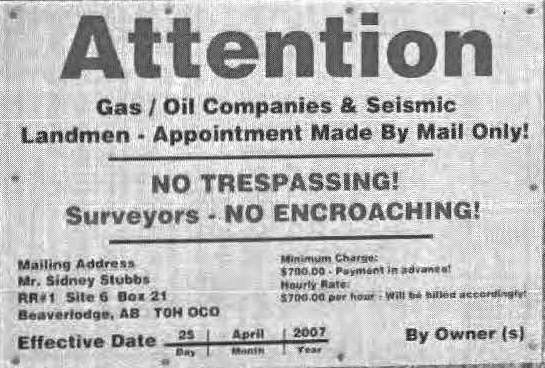
Sign at a property near Grande Prairie, Alberta, reprinted
from CAPL Course Notes.
CAPL thinks it's funny!
 NOISE
IMPACT ASSESSMENTS (NIA) NOISE
IMPACT ASSESSMENTS (NIA)
A Noise Impact Assessment (NIA) will be needed before
construction of compressor sites and other permanent noise
sources. Predicted sound levels must be below specific limits.
If there are other noise sources nearby, an NIA for the combined
facilities is required. NIAs may easily be "cooked" to keep the
predicted levels below these limits and always represent the
most optimistic weather and ground conditions. The facility will
usually be noisier than predicted, especially under adverse
weather conditions.
Noise Impact Assessments are public documents in most
jurisdictions. You have the right to read it and comment or
ask questions concerning its contents.
Noise Impact Assessments in Alberta are governed by
AER Directive 038. It covers
general requirements for short term noise, such as drilling
operations, and long term noise such as compressor sites and gas
plants. The regulations dictate how the facility noise level is
to be added to the assumed ambient background sound level. This
sum cannot exceed 50 dB in daytime and 40 dB nighttime at a
distance of 1500 meters.
Some of the required environmental conditions specified in the
Alberta regulations are routinely ignored by both the regulator
and the oil company operator, in particular those dealing with
cold weather, temperature inversion, combining multiple noise sources, and
extremes in weather conditions.
For example, AER D038 specifies in Paragraph 3.1 that a 5 dB
"safety margin" be made to account for adverse conditions. This
effectively reduce allowable noise levels by 5 dB, since
the NIA is performed using conditions that minimize
predicted noise levels. However, this requirement is routinely
ignored and no allowance is made for adverse conditions. In the
four NIAs I have reviewed on a nearby facility, all predicted
noise levels were above the allowable when the 5 dB safety
margin was used. My objection was refused on the grounds that
"the predicted noise level is well below the required value",
even though it was not. So much for truth and fair play.
The regulations require that the maximum allowable limit not be
exceeded at a radius of 1500 meters from the noise source.
However, if there are no residences affected by the noise, no
one is allowed to file a complaint even if the facility is well
above the legal limit. D038 claims there is no evidence that
noise affects wildlife. This is nonsense, if you were a bird who
couldn't hear a mating call, or a deer who couldn't hear a wolf
or coyote sneaking up, how long would you survive?
My advice: If you can hear it over other background noise, file
a written complaint with the appropriate regulatory agency and
with the President or CEO of the oil company. Send it by
Registered Mail - that gives proof of delivery. I know, "Nothing will happen". But if enough
complaints are received, over time there may be a sea-change and
common sense will prevail. If we don't speak up, I guarantee
nothing will change.
There are two calculations that you might want to do yourself if
you receive notice of a facility expansion or receive an NIA for
a facility near you.
 Distance
Calculator: Use
this if you have an NIA with a predicted noise level at a
specified distance from the source. Enter the Distance (r1) and
noise level at that distance (L1) into the shaded boxes. Enter
the distance to your residence from the nearest corner of the facility
(r2), then click "Calculate" button. In my case, the r1 distance
is 1500 meters, the L1 sound level is 38.0 dB (not including the
5 dB safety margin). My residence is 2490 meters (r2). This gives a
noise level at my house of 36.9 dB. This is the optimum case. If
5 dB is added for adverse conditions, the result is 41.9 dB at
my residence. What this means is that under optimum conditions,
I might not notice the compressor but under adverse conditions, I
will (and do). Distance
Calculator: Use
this if you have an NIA with a predicted noise level at a
specified distance from the source. Enter the Distance (r1) and
noise level at that distance (L1) into the shaded boxes. Enter
the distance to your residence from the nearest corner of the facility
(r2), then click "Calculate" button. In my case, the r1 distance
is 1500 meters, the L1 sound level is 38.0 dB (not including the
5 dB safety margin). My residence is 2490 meters (r2). This gives a
noise level at my house of 36.9 dB. This is the optimum case. If
5 dB is added for adverse conditions, the result is 41.9 dB at
my residence. What this means is that under optimum conditions,
I might not notice the compressor but under adverse conditions, I
will (and do).
The lower half of this calculator can be used to find the
distance that the facility would have to be located so as not to
impact your residence.
 Summation
Calculator: Use
this to calculate the sum of several sound levels. Suppose you
receive notice that the oil company wants to double the capacity
of an existing facility and also add a 5 million BTU heater and
a 2750 HP refrigeration unit. The
original facility has a sound level of 36.2 dB at the 1500 meter
boundary. On the calculator, enter 36.2 dB in the box beside
Level 1, put 36.2 in the box for Level 2 (the second
compressor), and 34 dB for the heater and refrig unit in Level 3, then click the
"Calculate" button. The result is 40.4 dB, which is over the
legal limit of 40.0 dB, even without counting the 5 dB safety
margin. So some redesign or retrofit would be needed to be
compliant. Summation
Calculator: Use
this to calculate the sum of several sound levels. Suppose you
receive notice that the oil company wants to double the capacity
of an existing facility and also add a 5 million BTU heater and
a 2750 HP refrigeration unit. The
original facility has a sound level of 36.2 dB at the 1500 meter
boundary. On the calculator, enter 36.2 dB in the box beside
Level 1, put 36.2 in the box for Level 2 (the second
compressor), and 34 dB for the heater and refrig unit in Level 3, then click the
"Calculate" button. The result is 40.4 dB, which is over the
legal limit of 40.0 dB, even without counting the 5 dB safety
margin. So some redesign or retrofit would be needed to be
compliant.

Copyright ©
2022
E. R. (Ross) Crain, P.Eng.
email
|


 Memorial To My Off-Grid Home
Memorial To My Off-Grid Home
















 The
access road to the property is covered by a License of Occupation
issued by the Provincial Government. It connects the end of Range
Road 9-0 through Crown Land to the southeast corner of the deeded
property. The License has been in existence since sometime in the
1960's. The road is maintained by the land owner.
The
access road to the property is covered by a License of Occupation
issued by the Provincial Government. It connects the end of Range
Road 9-0 through Crown Land to the southeast corner of the deeded
property. The License has been in existence since sometime in the
1960's. The road is maintained by the land owner. 



























 I
was proud of our weights and advertised them in 1982 and 1983,
well before the current emphasis on EPDs in modern advertising.
I
was proud of our weights and advertised them in 1982 and 1983,
well before the current emphasis on EPDs in modern advertising. Our
1983 herd sire advert still featured “Brownle” and
our statistics. We added cows from Stauffer Farms and the Bar
77 (Zane Block) dispersal. The Bar 77 cows were very modern for
their time, and lasted a long time at Rocking “Are”.
Daughters and grand daughters are still doing well here.
Our
1983 herd sire advert still featured “Brownle” and
our statistics. We added cows from Stauffer Farms and the Bar
77 (Zane Block) dispersal. The Bar 77 cows were very modern for
their time, and lasted a long time at Rocking “Are”.
Daughters and grand daughters are still doing well here. In
1984, we acquired the first of several proven bulls that significantly
improved our herd. PVC Britisher 29M came from the Pleasant Valley
Colony herd dispersal. He bred only one season prior to being
hit by lightning. “Brownie” bred his last group of
cows in 1984 and was retired from service.
In
1984, we acquired the first of several proven bulls that significantly
improved our herd. PVC Britisher 29M came from the Pleasant Valley
Colony herd dispersal. He bred only one season prior to being
hit by lightning. “Brownie” bred his last group of
cows in 1984 and was retired from service. I
arranged a bull sharing deal with Tom Irwin in 1985. I bred the
early season. He picked up the bulls on June 1 and he bred the
later season. One bull was wintered at each ranch. LCI Dermot
Lad 130P was a great bull but he was put down because of lumpjaw.
With 29M killed by lightning, we were out of bulls!
I
arranged a bull sharing deal with Tom Irwin in 1985. I bred the
early season. He picked up the bulls on June 1 and he bred the
later season. One bull was wintered at each ranch. LCI Dermot
Lad 130P was a great bull but he was put down because of lumpjaw.
With 29M killed by lightning, we were out of bulls! With
the death of 29M and 130P, I needed a new bull for 1986. HH Advance
N194 was obtained from the Peacock dispersal. He was a great cow
builder, leaving perfect udders and feet. He ranked in the top
thirty Canadian Herefords for weaning and yearling weights.
With
the death of 29M and 130P, I needed a new bull for 1986. HH Advance
N194 was obtained from the Peacock dispersal. He was a great cow
builder, leaving perfect udders and feet. He ranked in the top
thirty Canadian Herefords for weaning and yearling weights. In
1987, we put more effort into advertising. The double rainbow
photo taken in my front yard by my father was a dramatic symbol
of the pot of gold that Herefords could provide. No one ever commented
on the ad, but we used it as a background for several years.
In
1987, we put more effort into advertising. The double rainbow
photo taken in my front yard by my father was a dramatic symbol
of the pot of gold that Herefords could provide. No one ever commented
on the ad, but we used it as a background for several years. In
1990, we arranged a bull-sharing agreement with Art Link. He was
smitten by N194 and I really liked his 20P bull. We shared the
rainbow ad for several years. 96P was never used at Rocking “Are”
but he was a great performer at Link’s.
In
1990, we arranged a bull-sharing agreement with Art Link. He was
smitten by N194 and I really liked his 20P bull. We shared the
rainbow ad for several years. 96P was never used at Rocking “Are”
but he was a great performer at Link’s. We
used much the same joint
We
used much the same joint  We
acquired LCI Royal Red 83A from the Floyd Anderson dispersal.
We still had 41Z, 3X, and a good junior bull, so we were pretty
“bull-rich”. Our bull sharing with Art Link came to
a sad end with his untimely passing.
We
acquired LCI Royal Red 83A from the Floyd Anderson dispersal.
We still had 41Z, 3X, and a good junior bull, so we were pretty
“bull-rich”. Our bull sharing with Art Link came to
a sad end with his untimely passing. By
1996, two of the best maternal bulls in the industry, 3X and 83A,
were working at Rocking “Are”. With a good base of
N194 cows, and a number of other good “name-brand”
cows, our calves looked great. Private treaty sales made it difficult
to keep the herd at its normal size, although prices were not
as high as expected.
By
1996, two of the best maternal bulls in the industry, 3X and 83A,
were working at Rocking “Are”. With a good base of
N194 cows, and a number of other good “name-brand”
cows, our calves looked great. Private treaty sales made it difficult
to keep the herd at its normal size, although prices were not
as high as expected. In
1997, we took the top performing bull, DW Advance 9012Y Lad 6F,
from the AHA Test Center for our heifers. The bull was a great
disappointment as he left many open heifers. Semen tests showed
the reason so he was pounded. The open heifers sold high but this
is faint compensation for too much hot feed and no exercise at
test. Another lesson learned! His only son, semen-tested A-OK,
serviced our heifers for two years until he broke his leg in 2001
In
1997, we took the top performing bull, DW Advance 9012Y Lad 6F,
from the AHA Test Center for our heifers. The bull was a great
disappointment as he left many open heifers. Semen tests showed
the reason so he was pounded. The open heifers sold high but this
is faint compensation for too much hot feed and no exercise at
test. Another lesson learned! His only son, semen-tested A-OK,
serviced our heifers for two years until he broke his leg in 2001 1998
saw 3X pass away from old age a month before breeding season.
A few frantic phone calls and we found FA Silver Canadian ET 37D
available from Bjorger Pettersen’s Ranch of the Vikings.
1998
saw 3X pass away from old age a month before breeding season.
A few frantic phone calls and we found FA Silver Canadian ET 37D
available from Bjorger Pettersen’s Ranch of the Vikings.

 Three
years of drought have not hurt our grass due to careful monitoring
of our rotational grazing program, aided by some extra rain related
to our close proximity to the foothills and the North Saskatchewan
River. The swamps are dry, showing how far the water table has
dropped. Further North, East, and South, commercial herds are
suffering reductions.
Three
years of drought have not hurt our grass due to careful monitoring
of our rotational grazing program, aided by some extra rain related
to our close proximity to the foothills and the North Saskatchewan
River. The swamps are dry, showing how far the water table has
dropped. Further North, East, and South, commercial herds are
suffering reductions.
 In 2005,
I received my Canadian Hereford Association 25-Year pin at the
annual summer field day. Later that year, the heart of our herd was
sold to the Bohnet family of High River and the younger bred cows
were dispersed through Innisfail Auction. The bred heifers,
yearling bulls, and 2-year old bulls were sold in 2006.
In 2005,
I received my Canadian Hereford Association 25-Year pin at the
annual summer field day. Later that year, the heart of our herd was
sold to the Bohnet family of High River and the younger bred cows
were dispersed through Innisfail Auction. The bred heifers,
yearling bulls, and 2-year old bulls were sold in 2006. 

























































 BEFORE
discussing compensation with a Land Agent, first negotiate the
location of the proposed operation. If you discuss compensation
first, you have tacitly agreed to the oil company's location and
the compensation is related to that specific location. Be sure
the location is suitable to your operation and as far from your
residence as possible. With current technology, an operator can
reach its target from anywhere on a given quarter section.
BEFORE
discussing compensation with a Land Agent, first negotiate the
location of the proposed operation. If you discuss compensation
first, you have tacitly agreed to the oil company's location and
the compensation is related to that specific location. Be sure
the location is suitable to your operation and as far from your
residence as possible. With current technology, an operator can
reach its target from anywhere on a given quarter section.



